FINANCIAL CASE STUDY.
VerifiedAdded on 2023/04/21
|24
|4920
|133
AI Summary
Contribute Materials
Your contribution can guide someone’s learning journey. Share your
documents today.
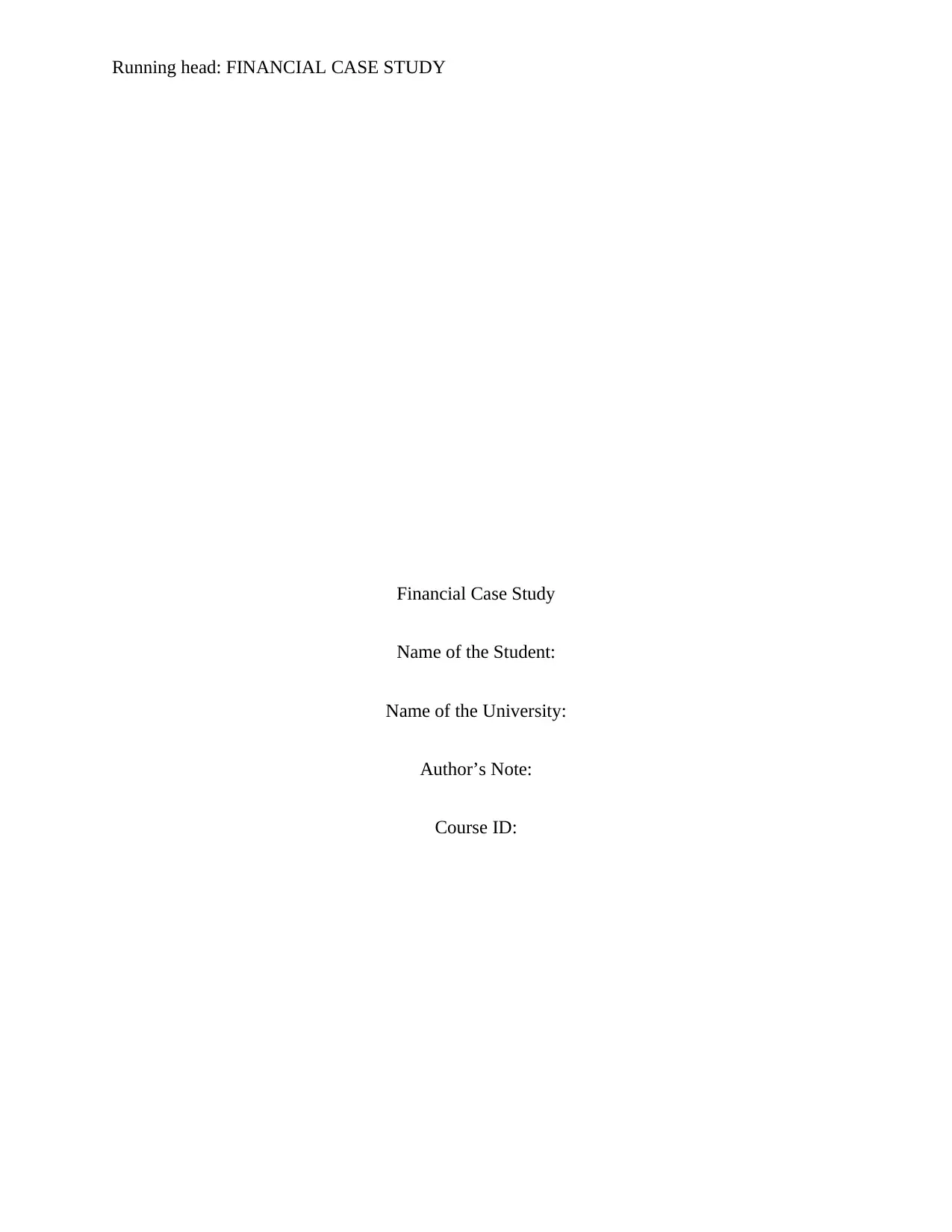
Running head: FINANCIAL CASE STUDY
Financial Case Study
Name of the Student:
Name of the University:
Author’s Note:
Course ID:
Financial Case Study
Name of the Student:
Name of the University:
Author’s Note:
Course ID:
Secure Best Marks with AI Grader
Need help grading? Try our AI Grader for instant feedback on your assignments.
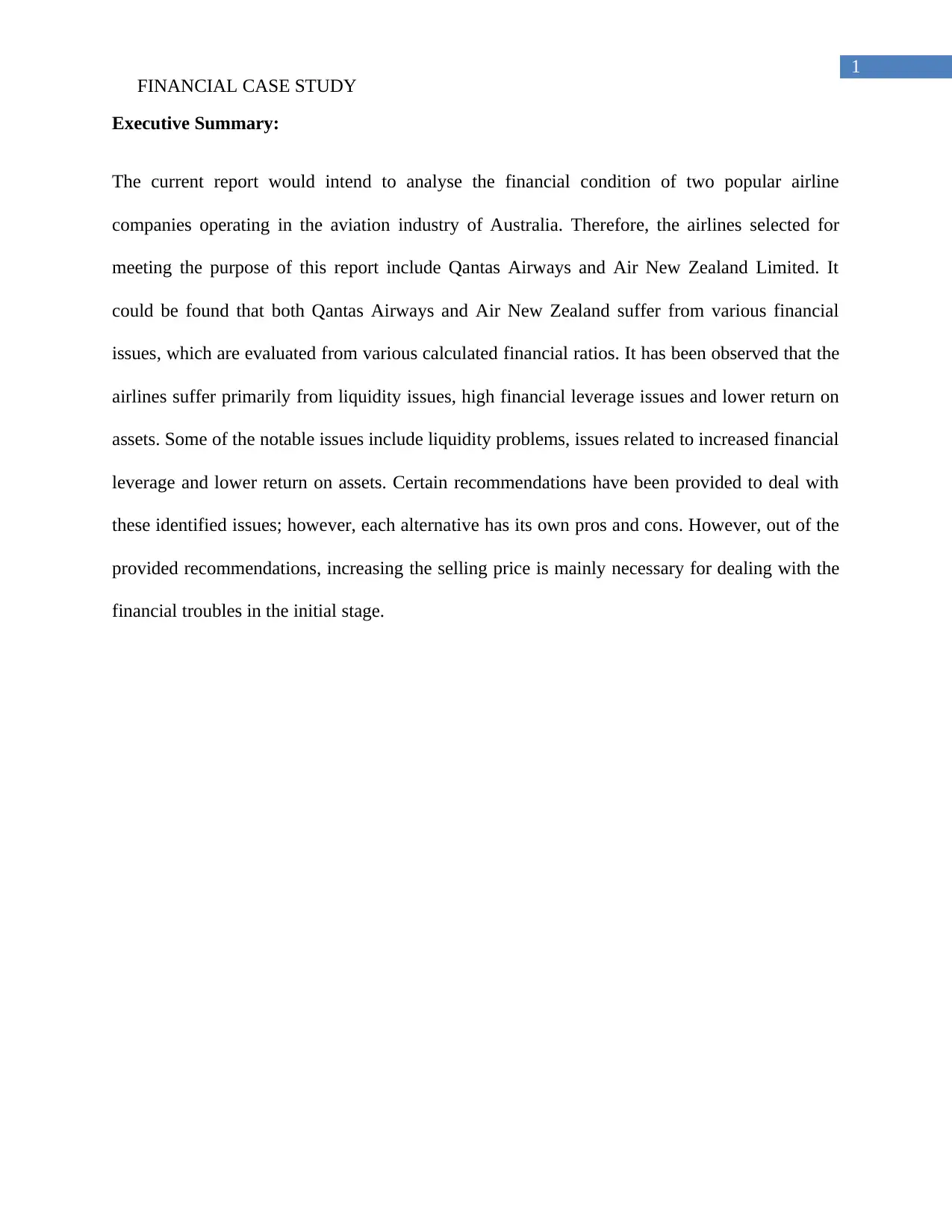
1
FINANCIAL CASE STUDY
Executive Summary:
The current report would intend to analyse the financial condition of two popular airline
companies operating in the aviation industry of Australia. Therefore, the airlines selected for
meeting the purpose of this report include Qantas Airways and Air New Zealand Limited. It
could be found that both Qantas Airways and Air New Zealand suffer from various financial
issues, which are evaluated from various calculated financial ratios. It has been observed that the
airlines suffer primarily from liquidity issues, high financial leverage issues and lower return on
assets. Some of the notable issues include liquidity problems, issues related to increased financial
leverage and lower return on assets. Certain recommendations have been provided to deal with
these identified issues; however, each alternative has its own pros and cons. However, out of the
provided recommendations, increasing the selling price is mainly necessary for dealing with the
financial troubles in the initial stage.
FINANCIAL CASE STUDY
Executive Summary:
The current report would intend to analyse the financial condition of two popular airline
companies operating in the aviation industry of Australia. Therefore, the airlines selected for
meeting the purpose of this report include Qantas Airways and Air New Zealand Limited. It
could be found that both Qantas Airways and Air New Zealand suffer from various financial
issues, which are evaluated from various calculated financial ratios. It has been observed that the
airlines suffer primarily from liquidity issues, high financial leverage issues and lower return on
assets. Some of the notable issues include liquidity problems, issues related to increased financial
leverage and lower return on assets. Certain recommendations have been provided to deal with
these identified issues; however, each alternative has its own pros and cons. However, out of the
provided recommendations, increasing the selling price is mainly necessary for dealing with the
financial troubles in the initial stage.
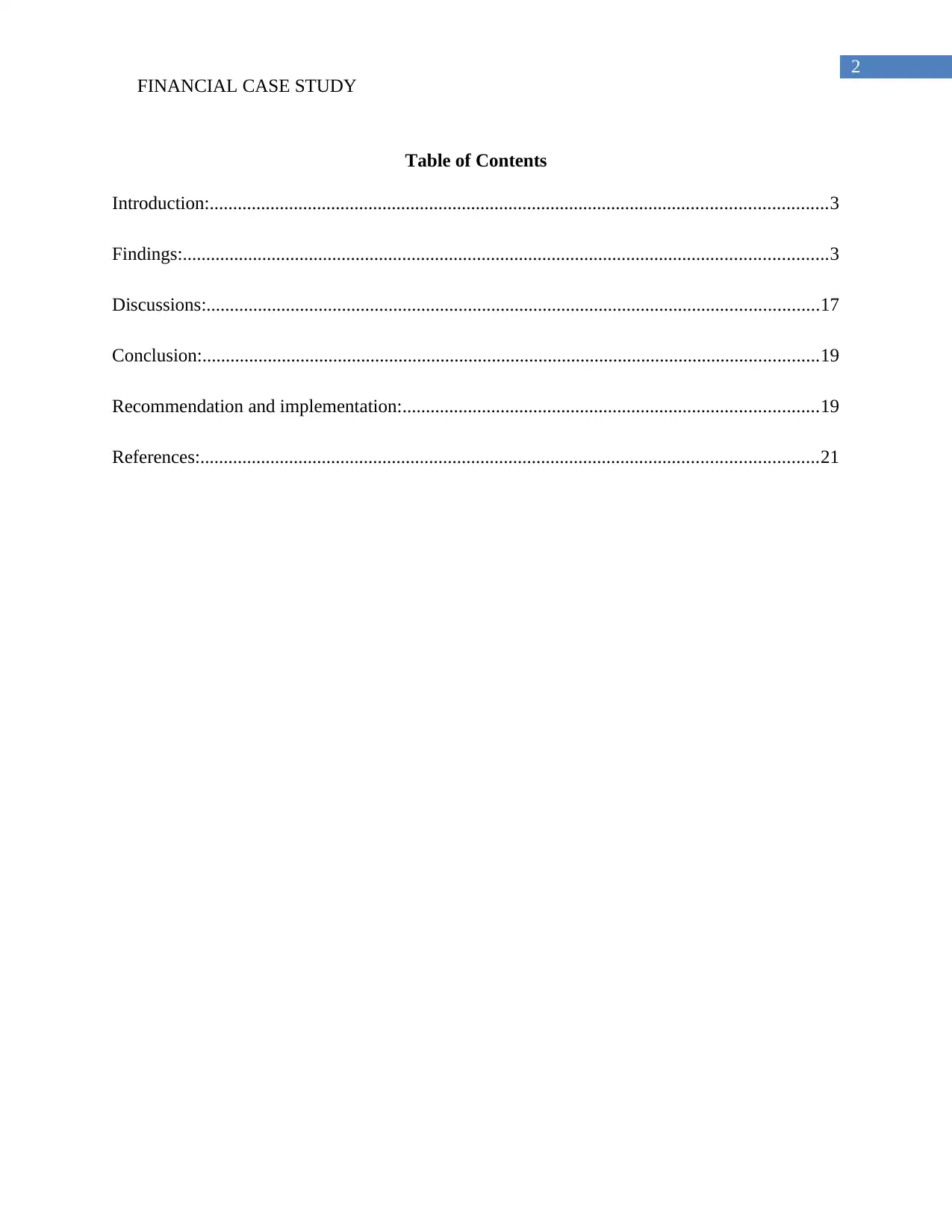
2
FINANCIAL CASE STUDY
Table of Contents
Introduction:....................................................................................................................................3
Findings:..........................................................................................................................................3
Discussions:...................................................................................................................................17
Conclusion:....................................................................................................................................19
Recommendation and implementation:.........................................................................................19
References:....................................................................................................................................21
FINANCIAL CASE STUDY
Table of Contents
Introduction:....................................................................................................................................3
Findings:..........................................................................................................................................3
Discussions:...................................................................................................................................17
Conclusion:....................................................................................................................................19
Recommendation and implementation:.........................................................................................19
References:....................................................................................................................................21
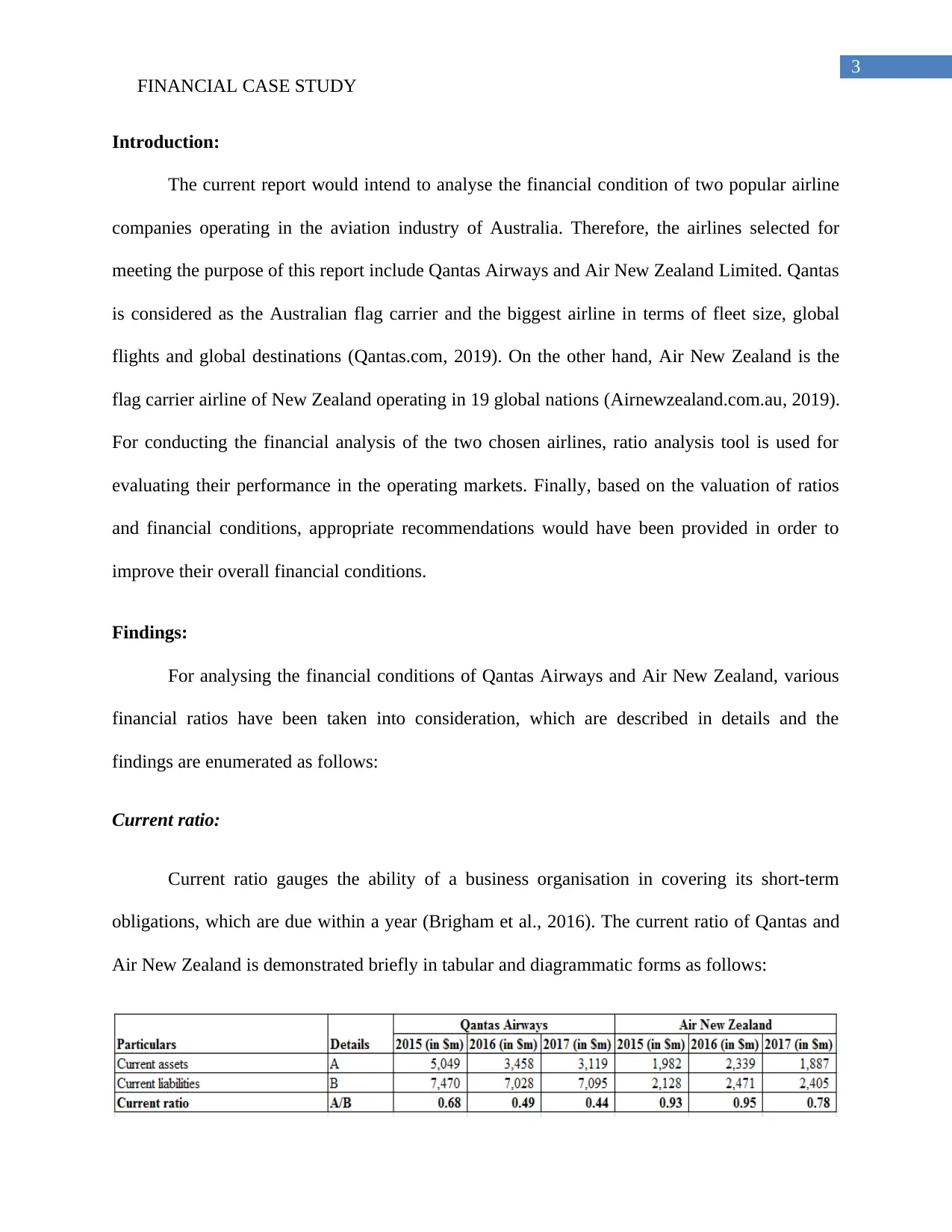
3
FINANCIAL CASE STUDY
Introduction:
The current report would intend to analyse the financial condition of two popular airline
companies operating in the aviation industry of Australia. Therefore, the airlines selected for
meeting the purpose of this report include Qantas Airways and Air New Zealand Limited. Qantas
is considered as the Australian flag carrier and the biggest airline in terms of fleet size, global
flights and global destinations (Qantas.com, 2019). On the other hand, Air New Zealand is the
flag carrier airline of New Zealand operating in 19 global nations (Airnewzealand.com.au, 2019).
For conducting the financial analysis of the two chosen airlines, ratio analysis tool is used for
evaluating their performance in the operating markets. Finally, based on the valuation of ratios
and financial conditions, appropriate recommendations would have been provided in order to
improve their overall financial conditions.
Findings:
For analysing the financial conditions of Qantas Airways and Air New Zealand, various
financial ratios have been taken into consideration, which are described in details and the
findings are enumerated as follows:
Current ratio:
Current ratio gauges the ability of a business organisation in covering its short-term
obligations, which are due within a year (Brigham et al., 2016). The current ratio of Qantas and
Air New Zealand is demonstrated briefly in tabular and diagrammatic forms as follows:
FINANCIAL CASE STUDY
Introduction:
The current report would intend to analyse the financial condition of two popular airline
companies operating in the aviation industry of Australia. Therefore, the airlines selected for
meeting the purpose of this report include Qantas Airways and Air New Zealand Limited. Qantas
is considered as the Australian flag carrier and the biggest airline in terms of fleet size, global
flights and global destinations (Qantas.com, 2019). On the other hand, Air New Zealand is the
flag carrier airline of New Zealand operating in 19 global nations (Airnewzealand.com.au, 2019).
For conducting the financial analysis of the two chosen airlines, ratio analysis tool is used for
evaluating their performance in the operating markets. Finally, based on the valuation of ratios
and financial conditions, appropriate recommendations would have been provided in order to
improve their overall financial conditions.
Findings:
For analysing the financial conditions of Qantas Airways and Air New Zealand, various
financial ratios have been taken into consideration, which are described in details and the
findings are enumerated as follows:
Current ratio:
Current ratio gauges the ability of a business organisation in covering its short-term
obligations, which are due within a year (Brigham et al., 2016). The current ratio of Qantas and
Air New Zealand is demonstrated briefly in tabular and diagrammatic forms as follows:
Secure Best Marks with AI Grader
Need help grading? Try our AI Grader for instant feedback on your assignments.
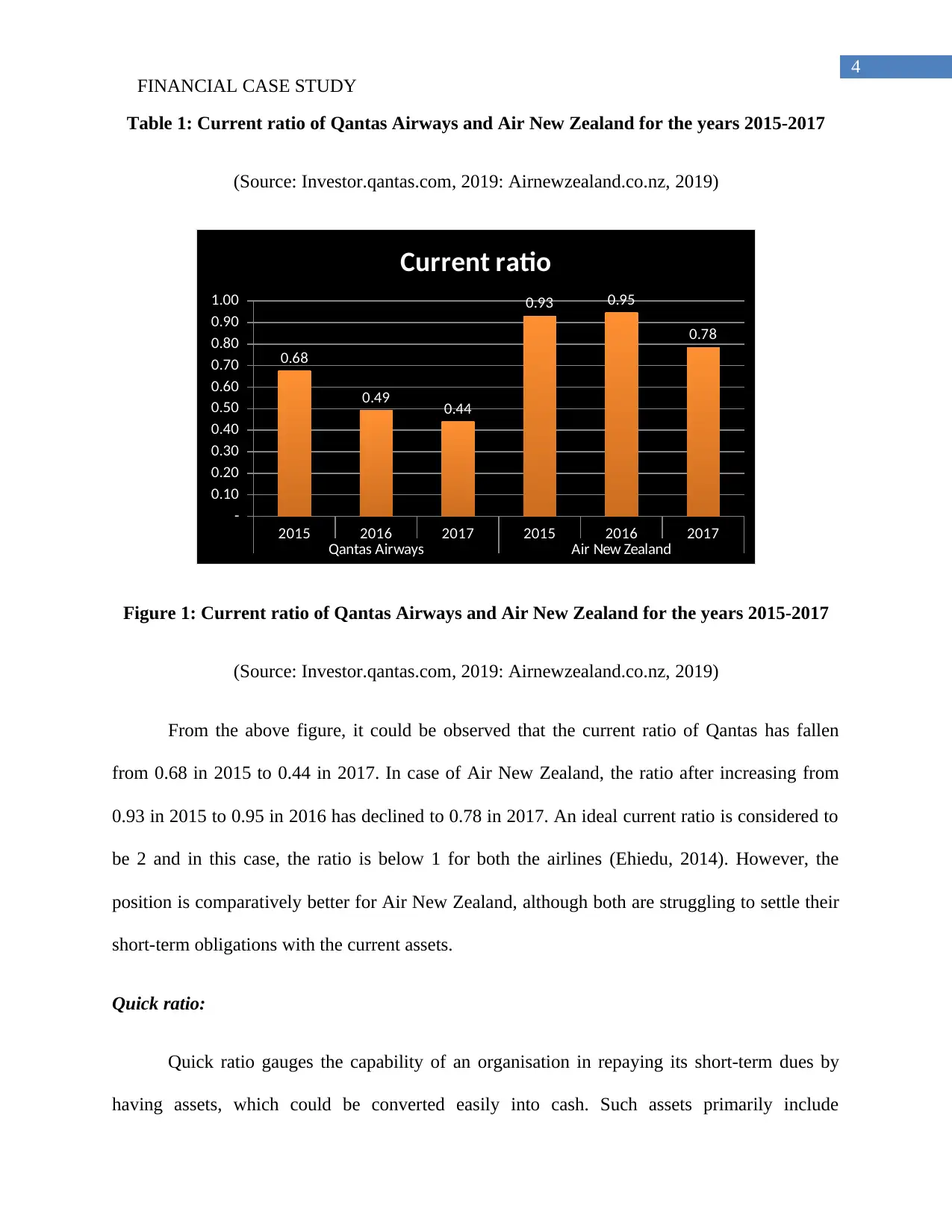
4
FINANCIAL CASE STUDY
Table 1: Current ratio of Qantas Airways and Air New Zealand for the years 2015-2017
(Source: Investor.qantas.com, 2019: Airnewzealand.co.nz, 2019)
2015 2016 2017 2015 2016 2017
Qantas Airways Air New Zealand
-
0.10
0.20
0.30
0.40
0.50
0.60
0.70
0.80
0.90
1.00
0.68
0.49 0.44
0.93 0.95
0.78
Current ratio
Figure 1: Current ratio of Qantas Airways and Air New Zealand for the years 2015-2017
(Source: Investor.qantas.com, 2019: Airnewzealand.co.nz, 2019)
From the above figure, it could be observed that the current ratio of Qantas has fallen
from 0.68 in 2015 to 0.44 in 2017. In case of Air New Zealand, the ratio after increasing from
0.93 in 2015 to 0.95 in 2016 has declined to 0.78 in 2017. An ideal current ratio is considered to
be 2 and in this case, the ratio is below 1 for both the airlines (Ehiedu, 2014). However, the
position is comparatively better for Air New Zealand, although both are struggling to settle their
short-term obligations with the current assets.
Quick ratio:
Quick ratio gauges the capability of an organisation in repaying its short-term dues by
having assets, which could be converted easily into cash. Such assets primarily include
FINANCIAL CASE STUDY
Table 1: Current ratio of Qantas Airways and Air New Zealand for the years 2015-2017
(Source: Investor.qantas.com, 2019: Airnewzealand.co.nz, 2019)
2015 2016 2017 2015 2016 2017
Qantas Airways Air New Zealand
-
0.10
0.20
0.30
0.40
0.50
0.60
0.70
0.80
0.90
1.00
0.68
0.49 0.44
0.93 0.95
0.78
Current ratio
Figure 1: Current ratio of Qantas Airways and Air New Zealand for the years 2015-2017
(Source: Investor.qantas.com, 2019: Airnewzealand.co.nz, 2019)
From the above figure, it could be observed that the current ratio of Qantas has fallen
from 0.68 in 2015 to 0.44 in 2017. In case of Air New Zealand, the ratio after increasing from
0.93 in 2015 to 0.95 in 2016 has declined to 0.78 in 2017. An ideal current ratio is considered to
be 2 and in this case, the ratio is below 1 for both the airlines (Ehiedu, 2014). However, the
position is comparatively better for Air New Zealand, although both are struggling to settle their
short-term obligations with the current assets.
Quick ratio:
Quick ratio gauges the capability of an organisation in repaying its short-term dues by
having assets, which could be converted easily into cash. Such assets primarily include
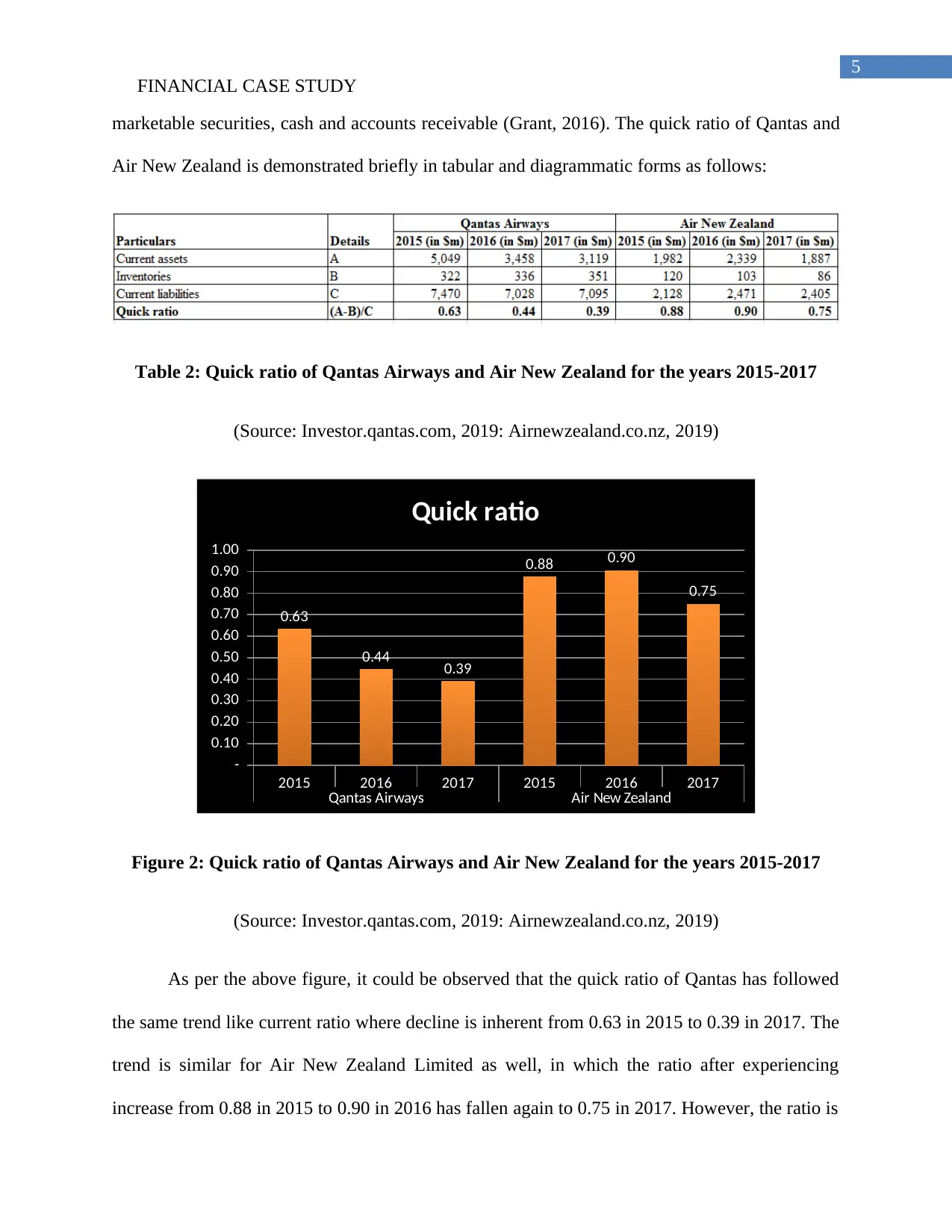
5
FINANCIAL CASE STUDY
marketable securities, cash and accounts receivable (Grant, 2016). The quick ratio of Qantas and
Air New Zealand is demonstrated briefly in tabular and diagrammatic forms as follows:
Table 2: Quick ratio of Qantas Airways and Air New Zealand for the years 2015-2017
(Source: Investor.qantas.com, 2019: Airnewzealand.co.nz, 2019)
2015 2016 2017 2015 2016 2017
Qantas Airways Air New Zealand
-
0.10
0.20
0.30
0.40
0.50
0.60
0.70
0.80
0.90
1.00
0.63
0.44 0.39
0.88 0.90
0.75
Quick ratio
Figure 2: Quick ratio of Qantas Airways and Air New Zealand for the years 2015-2017
(Source: Investor.qantas.com, 2019: Airnewzealand.co.nz, 2019)
As per the above figure, it could be observed that the quick ratio of Qantas has followed
the same trend like current ratio where decline is inherent from 0.63 in 2015 to 0.39 in 2017. The
trend is similar for Air New Zealand Limited as well, in which the ratio after experiencing
increase from 0.88 in 2015 to 0.90 in 2016 has fallen again to 0.75 in 2017. However, the ratio is
FINANCIAL CASE STUDY
marketable securities, cash and accounts receivable (Grant, 2016). The quick ratio of Qantas and
Air New Zealand is demonstrated briefly in tabular and diagrammatic forms as follows:
Table 2: Quick ratio of Qantas Airways and Air New Zealand for the years 2015-2017
(Source: Investor.qantas.com, 2019: Airnewzealand.co.nz, 2019)
2015 2016 2017 2015 2016 2017
Qantas Airways Air New Zealand
-
0.10
0.20
0.30
0.40
0.50
0.60
0.70
0.80
0.90
1.00
0.63
0.44 0.39
0.88 0.90
0.75
Quick ratio
Figure 2: Quick ratio of Qantas Airways and Air New Zealand for the years 2015-2017
(Source: Investor.qantas.com, 2019: Airnewzealand.co.nz, 2019)
As per the above figure, it could be observed that the quick ratio of Qantas has followed
the same trend like current ratio where decline is inherent from 0.63 in 2015 to 0.39 in 2017. The
trend is similar for Air New Zealand Limited as well, in which the ratio after experiencing
increase from 0.88 in 2015 to 0.90 in 2016 has fallen again to 0.75 in 2017. However, the ratio is
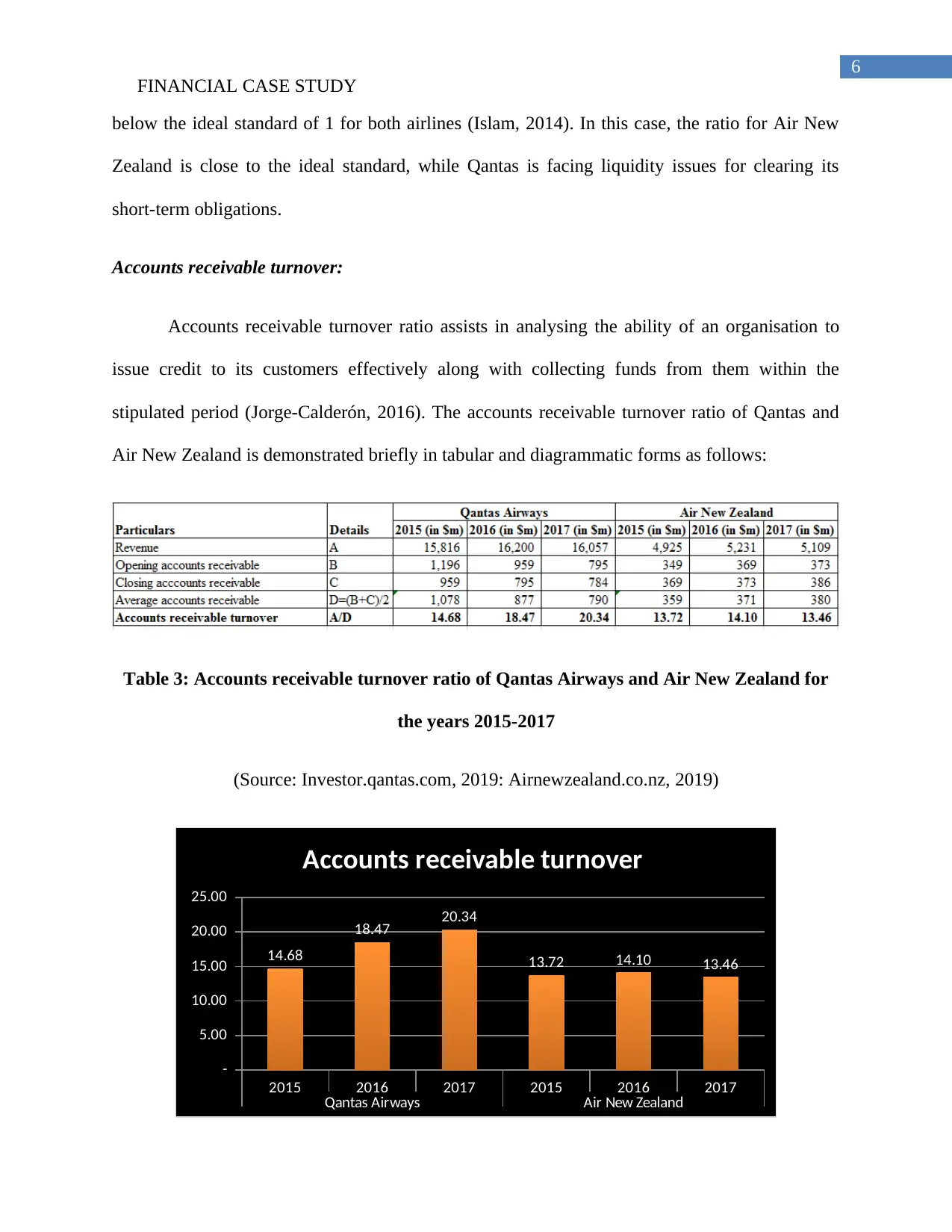
6
FINANCIAL CASE STUDY
below the ideal standard of 1 for both airlines (Islam, 2014). In this case, the ratio for Air New
Zealand is close to the ideal standard, while Qantas is facing liquidity issues for clearing its
short-term obligations.
Accounts receivable turnover:
Accounts receivable turnover ratio assists in analysing the ability of an organisation to
issue credit to its customers effectively along with collecting funds from them within the
stipulated period (Jorge-Calderón, 2016). The accounts receivable turnover ratio of Qantas and
Air New Zealand is demonstrated briefly in tabular and diagrammatic forms as follows:
Table 3: Accounts receivable turnover ratio of Qantas Airways and Air New Zealand for
the years 2015-2017
(Source: Investor.qantas.com, 2019: Airnewzealand.co.nz, 2019)
2015 2016 2017 2015 2016 2017
Qantas Airways Air New Zealand
-
5.00
10.00
15.00
20.00
25.00
14.68
18.47 20.34
13.72 14.10 13.46
Accounts receivable turnover
FINANCIAL CASE STUDY
below the ideal standard of 1 for both airlines (Islam, 2014). In this case, the ratio for Air New
Zealand is close to the ideal standard, while Qantas is facing liquidity issues for clearing its
short-term obligations.
Accounts receivable turnover:
Accounts receivable turnover ratio assists in analysing the ability of an organisation to
issue credit to its customers effectively along with collecting funds from them within the
stipulated period (Jorge-Calderón, 2016). The accounts receivable turnover ratio of Qantas and
Air New Zealand is demonstrated briefly in tabular and diagrammatic forms as follows:
Table 3: Accounts receivable turnover ratio of Qantas Airways and Air New Zealand for
the years 2015-2017
(Source: Investor.qantas.com, 2019: Airnewzealand.co.nz, 2019)
2015 2016 2017 2015 2016 2017
Qantas Airways Air New Zealand
-
5.00
10.00
15.00
20.00
25.00
14.68
18.47 20.34
13.72 14.10 13.46
Accounts receivable turnover
Paraphrase This Document
Need a fresh take? Get an instant paraphrase of this document with our AI Paraphraser
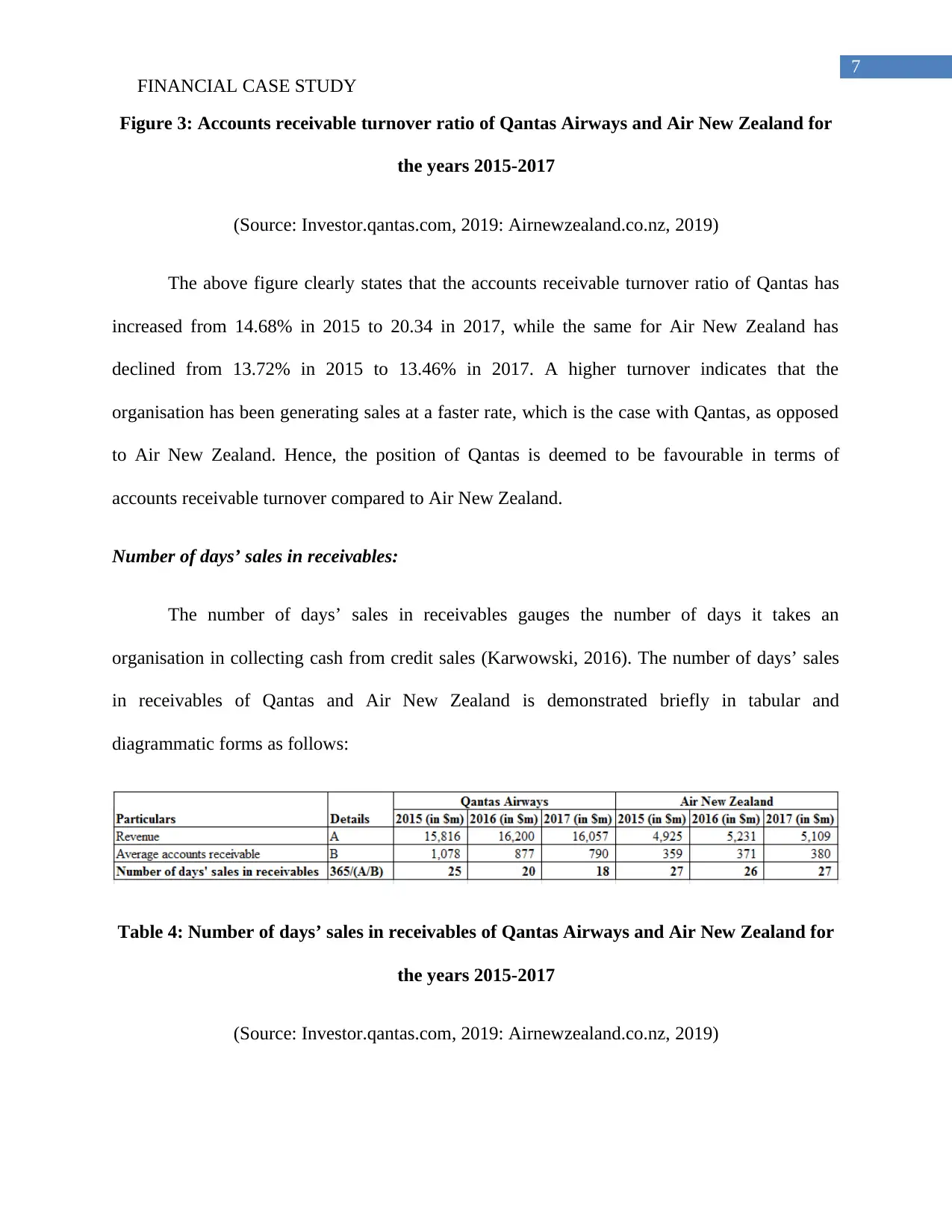
7
FINANCIAL CASE STUDY
Figure 3: Accounts receivable turnover ratio of Qantas Airways and Air New Zealand for
the years 2015-2017
(Source: Investor.qantas.com, 2019: Airnewzealand.co.nz, 2019)
The above figure clearly states that the accounts receivable turnover ratio of Qantas has
increased from 14.68% in 2015 to 20.34 in 2017, while the same for Air New Zealand has
declined from 13.72% in 2015 to 13.46% in 2017. A higher turnover indicates that the
organisation has been generating sales at a faster rate, which is the case with Qantas, as opposed
to Air New Zealand. Hence, the position of Qantas is deemed to be favourable in terms of
accounts receivable turnover compared to Air New Zealand.
Number of days’ sales in receivables:
The number of days’ sales in receivables gauges the number of days it takes an
organisation in collecting cash from credit sales (Karwowski, 2016). The number of days’ sales
in receivables of Qantas and Air New Zealand is demonstrated briefly in tabular and
diagrammatic forms as follows:
Table 4: Number of days’ sales in receivables of Qantas Airways and Air New Zealand for
the years 2015-2017
(Source: Investor.qantas.com, 2019: Airnewzealand.co.nz, 2019)
FINANCIAL CASE STUDY
Figure 3: Accounts receivable turnover ratio of Qantas Airways and Air New Zealand for
the years 2015-2017
(Source: Investor.qantas.com, 2019: Airnewzealand.co.nz, 2019)
The above figure clearly states that the accounts receivable turnover ratio of Qantas has
increased from 14.68% in 2015 to 20.34 in 2017, while the same for Air New Zealand has
declined from 13.72% in 2015 to 13.46% in 2017. A higher turnover indicates that the
organisation has been generating sales at a faster rate, which is the case with Qantas, as opposed
to Air New Zealand. Hence, the position of Qantas is deemed to be favourable in terms of
accounts receivable turnover compared to Air New Zealand.
Number of days’ sales in receivables:
The number of days’ sales in receivables gauges the number of days it takes an
organisation in collecting cash from credit sales (Karwowski, 2016). The number of days’ sales
in receivables of Qantas and Air New Zealand is demonstrated briefly in tabular and
diagrammatic forms as follows:
Table 4: Number of days’ sales in receivables of Qantas Airways and Air New Zealand for
the years 2015-2017
(Source: Investor.qantas.com, 2019: Airnewzealand.co.nz, 2019)
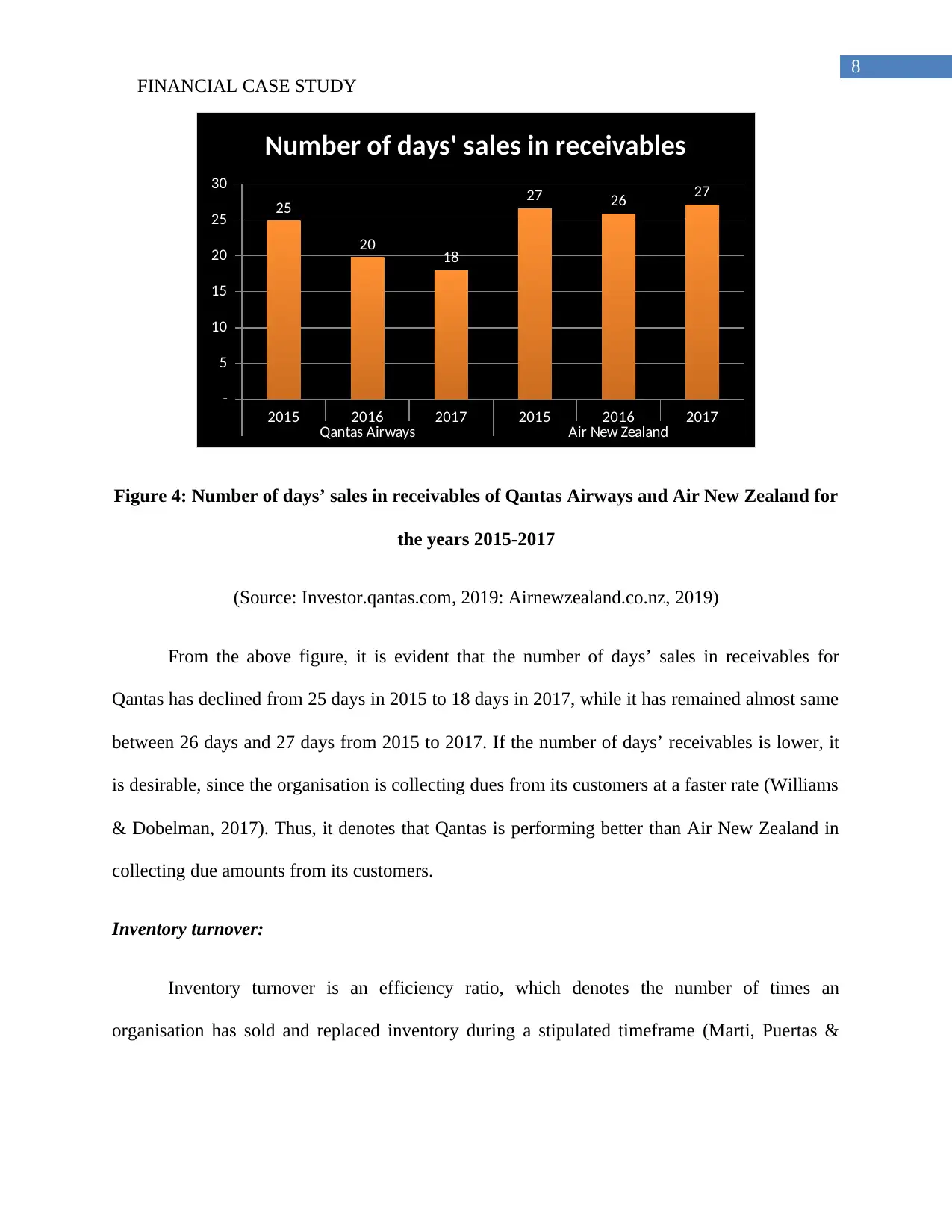
8
FINANCIAL CASE STUDY
2015 2016 2017 2015 2016 2017
Qantas Airways Air New Zealand
-
5
10
15
20
25
30
25
20 18
27 26 27
Number of days' sales in receivables
Figure 4: Number of days’ sales in receivables of Qantas Airways and Air New Zealand for
the years 2015-2017
(Source: Investor.qantas.com, 2019: Airnewzealand.co.nz, 2019)
From the above figure, it is evident that the number of days’ sales in receivables for
Qantas has declined from 25 days in 2015 to 18 days in 2017, while it has remained almost same
between 26 days and 27 days from 2015 to 2017. If the number of days’ receivables is lower, it
is desirable, since the organisation is collecting dues from its customers at a faster rate (Williams
& Dobelman, 2017). Thus, it denotes that Qantas is performing better than Air New Zealand in
collecting due amounts from its customers.
Inventory turnover:
Inventory turnover is an efficiency ratio, which denotes the number of times an
organisation has sold and replaced inventory during a stipulated timeframe (Marti, Puertas &
FINANCIAL CASE STUDY
2015 2016 2017 2015 2016 2017
Qantas Airways Air New Zealand
-
5
10
15
20
25
30
25
20 18
27 26 27
Number of days' sales in receivables
Figure 4: Number of days’ sales in receivables of Qantas Airways and Air New Zealand for
the years 2015-2017
(Source: Investor.qantas.com, 2019: Airnewzealand.co.nz, 2019)
From the above figure, it is evident that the number of days’ sales in receivables for
Qantas has declined from 25 days in 2015 to 18 days in 2017, while it has remained almost same
between 26 days and 27 days from 2015 to 2017. If the number of days’ receivables is lower, it
is desirable, since the organisation is collecting dues from its customers at a faster rate (Williams
& Dobelman, 2017). Thus, it denotes that Qantas is performing better than Air New Zealand in
collecting due amounts from its customers.
Inventory turnover:
Inventory turnover is an efficiency ratio, which denotes the number of times an
organisation has sold and replaced inventory during a stipulated timeframe (Marti, Puertas &
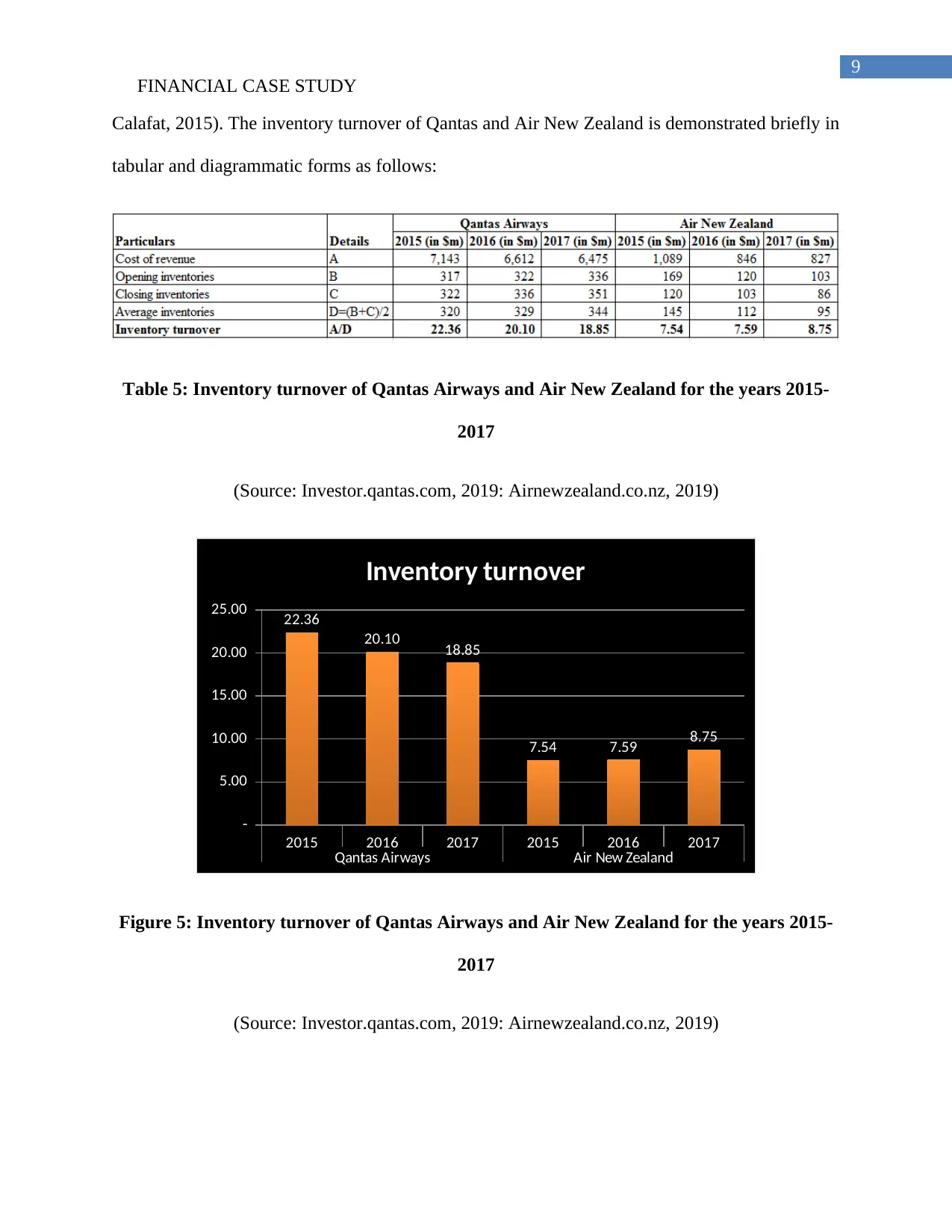
9
FINANCIAL CASE STUDY
Calafat, 2015). The inventory turnover of Qantas and Air New Zealand is demonstrated briefly in
tabular and diagrammatic forms as follows:
Table 5: Inventory turnover of Qantas Airways and Air New Zealand for the years 2015-
2017
(Source: Investor.qantas.com, 2019: Airnewzealand.co.nz, 2019)
2015 2016 2017 2015 2016 2017
Qantas Airways Air New Zealand
-
5.00
10.00
15.00
20.00
25.00 22.36
20.10 18.85
7.54 7.59 8.75
Inventory turnover
Figure 5: Inventory turnover of Qantas Airways and Air New Zealand for the years 2015-
2017
(Source: Investor.qantas.com, 2019: Airnewzealand.co.nz, 2019)
FINANCIAL CASE STUDY
Calafat, 2015). The inventory turnover of Qantas and Air New Zealand is demonstrated briefly in
tabular and diagrammatic forms as follows:
Table 5: Inventory turnover of Qantas Airways and Air New Zealand for the years 2015-
2017
(Source: Investor.qantas.com, 2019: Airnewzealand.co.nz, 2019)
2015 2016 2017 2015 2016 2017
Qantas Airways Air New Zealand
-
5.00
10.00
15.00
20.00
25.00 22.36
20.10 18.85
7.54 7.59 8.75
Inventory turnover
Figure 5: Inventory turnover of Qantas Airways and Air New Zealand for the years 2015-
2017
(Source: Investor.qantas.com, 2019: Airnewzealand.co.nz, 2019)
Secure Best Marks with AI Grader
Need help grading? Try our AI Grader for instant feedback on your assignments.
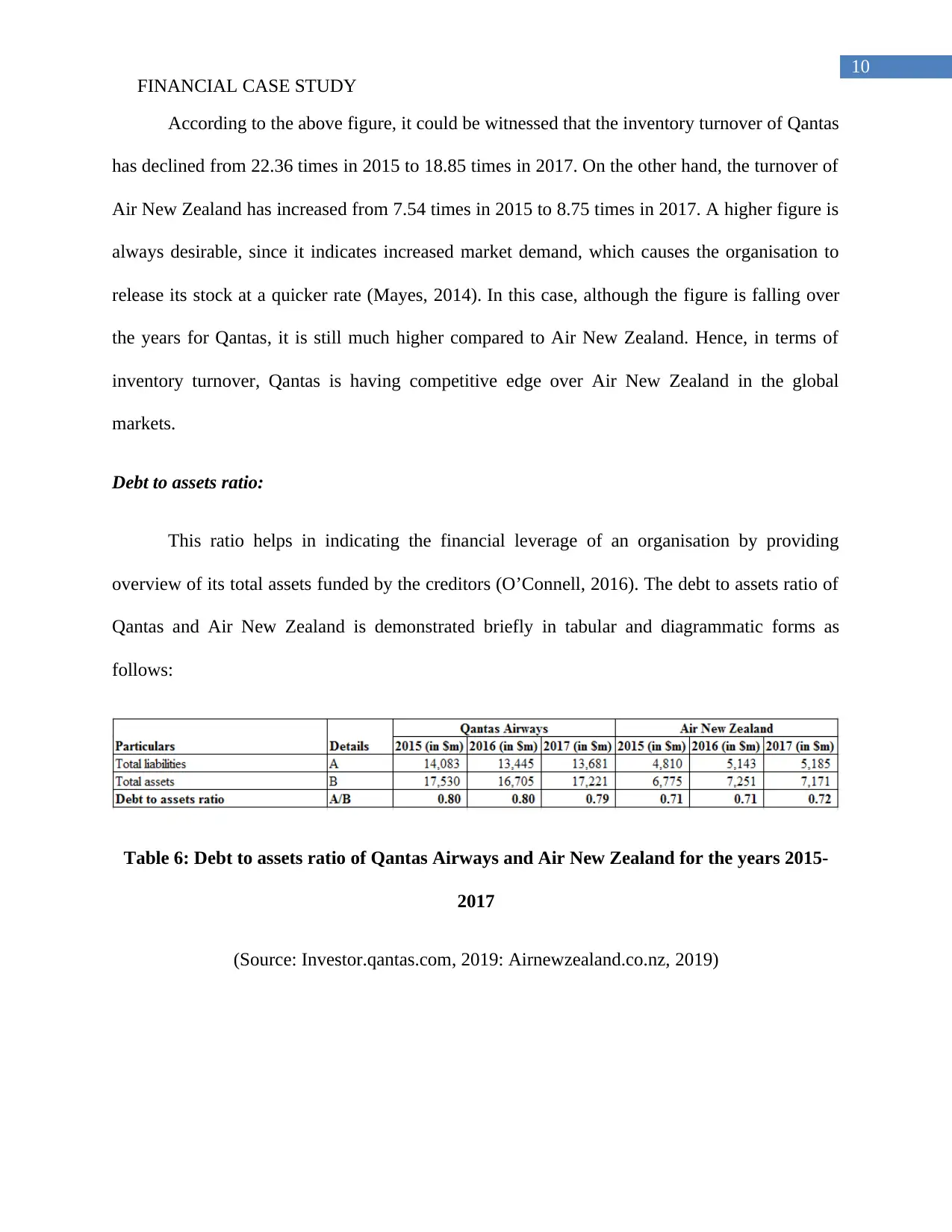
10
FINANCIAL CASE STUDY
According to the above figure, it could be witnessed that the inventory turnover of Qantas
has declined from 22.36 times in 2015 to 18.85 times in 2017. On the other hand, the turnover of
Air New Zealand has increased from 7.54 times in 2015 to 8.75 times in 2017. A higher figure is
always desirable, since it indicates increased market demand, which causes the organisation to
release its stock at a quicker rate (Mayes, 2014). In this case, although the figure is falling over
the years for Qantas, it is still much higher compared to Air New Zealand. Hence, in terms of
inventory turnover, Qantas is having competitive edge over Air New Zealand in the global
markets.
Debt to assets ratio:
This ratio helps in indicating the financial leverage of an organisation by providing
overview of its total assets funded by the creditors (O’Connell, 2016). The debt to assets ratio of
Qantas and Air New Zealand is demonstrated briefly in tabular and diagrammatic forms as
follows:
Table 6: Debt to assets ratio of Qantas Airways and Air New Zealand for the years 2015-
2017
(Source: Investor.qantas.com, 2019: Airnewzealand.co.nz, 2019)
FINANCIAL CASE STUDY
According to the above figure, it could be witnessed that the inventory turnover of Qantas
has declined from 22.36 times in 2015 to 18.85 times in 2017. On the other hand, the turnover of
Air New Zealand has increased from 7.54 times in 2015 to 8.75 times in 2017. A higher figure is
always desirable, since it indicates increased market demand, which causes the organisation to
release its stock at a quicker rate (Mayes, 2014). In this case, although the figure is falling over
the years for Qantas, it is still much higher compared to Air New Zealand. Hence, in terms of
inventory turnover, Qantas is having competitive edge over Air New Zealand in the global
markets.
Debt to assets ratio:
This ratio helps in indicating the financial leverage of an organisation by providing
overview of its total assets funded by the creditors (O’Connell, 2016). The debt to assets ratio of
Qantas and Air New Zealand is demonstrated briefly in tabular and diagrammatic forms as
follows:
Table 6: Debt to assets ratio of Qantas Airways and Air New Zealand for the years 2015-
2017
(Source: Investor.qantas.com, 2019: Airnewzealand.co.nz, 2019)

11
FINANCIAL CASE STUDY
2015 2016 2017 2015 2016 2017
Qantas Airways Air New Zealand
0.66
0.68
0.70
0.72
0.74
0.76
0.78
0.80
0.82 0.80 0.80 0.79
0.71 0.71
0.72
Debt to assets ratio
Figure 6: Debt to assets ratio of Qantas Airways and Air New Zealand for the years 2015-
2017
(Source: Investor.qantas.com, 2019: Airnewzealand.co.nz, 2019)
From the above figure, it could be seen that the debt to assets ratio of Qantas has
remained same at 0.80 in both 2015 and 2016, which has fallen slightly to 0.79 in 2017. On the
other hand, the ratio for Air New Zealand has remained identical at 0.71 in 2015 and 2016,
which has increased slightly to 0.72 in 2017. This implies that both the airlines fund their assets
by using debt funding. However, the ratio seems to be lower than Air New Zealand, which
implies that it is less leveraged, compared to Qantas Airways.
Debt to equity ratio:
This ratio assists in gauging the association between the amount contributed by the
creditors and the amount contributed by the shareholders in a business organisation (Pearson &
FINANCIAL CASE STUDY
2015 2016 2017 2015 2016 2017
Qantas Airways Air New Zealand
0.66
0.68
0.70
0.72
0.74
0.76
0.78
0.80
0.82 0.80 0.80 0.79
0.71 0.71
0.72
Debt to assets ratio
Figure 6: Debt to assets ratio of Qantas Airways and Air New Zealand for the years 2015-
2017
(Source: Investor.qantas.com, 2019: Airnewzealand.co.nz, 2019)
From the above figure, it could be seen that the debt to assets ratio of Qantas has
remained same at 0.80 in both 2015 and 2016, which has fallen slightly to 0.79 in 2017. On the
other hand, the ratio for Air New Zealand has remained identical at 0.71 in 2015 and 2016,
which has increased slightly to 0.72 in 2017. This implies that both the airlines fund their assets
by using debt funding. However, the ratio seems to be lower than Air New Zealand, which
implies that it is less leveraged, compared to Qantas Airways.
Debt to equity ratio:
This ratio assists in gauging the association between the amount contributed by the
creditors and the amount contributed by the shareholders in a business organisation (Pearson &
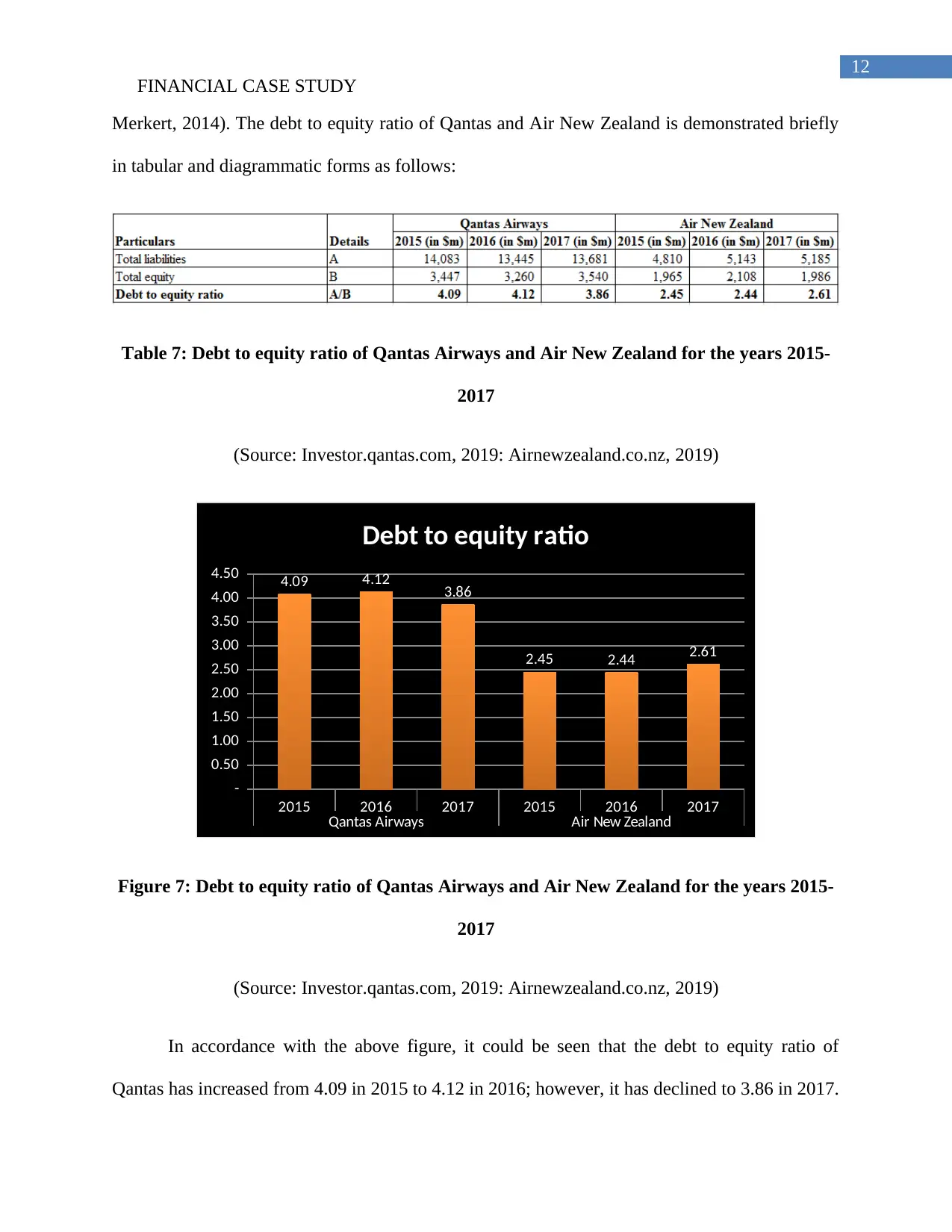
12
FINANCIAL CASE STUDY
Merkert, 2014). The debt to equity ratio of Qantas and Air New Zealand is demonstrated briefly
in tabular and diagrammatic forms as follows:
Table 7: Debt to equity ratio of Qantas Airways and Air New Zealand for the years 2015-
2017
(Source: Investor.qantas.com, 2019: Airnewzealand.co.nz, 2019)
2015 2016 2017 2015 2016 2017
Qantas Airways Air New Zealand
-
0.50
1.00
1.50
2.00
2.50
3.00
3.50
4.00
4.50 4.09 4.12 3.86
2.45 2.44 2.61
Debt to equity ratio
Figure 7: Debt to equity ratio of Qantas Airways and Air New Zealand for the years 2015-
2017
(Source: Investor.qantas.com, 2019: Airnewzealand.co.nz, 2019)
In accordance with the above figure, it could be seen that the debt to equity ratio of
Qantas has increased from 4.09 in 2015 to 4.12 in 2016; however, it has declined to 3.86 in 2017.
FINANCIAL CASE STUDY
Merkert, 2014). The debt to equity ratio of Qantas and Air New Zealand is demonstrated briefly
in tabular and diagrammatic forms as follows:
Table 7: Debt to equity ratio of Qantas Airways and Air New Zealand for the years 2015-
2017
(Source: Investor.qantas.com, 2019: Airnewzealand.co.nz, 2019)
2015 2016 2017 2015 2016 2017
Qantas Airways Air New Zealand
-
0.50
1.00
1.50
2.00
2.50
3.00
3.50
4.00
4.50 4.09 4.12 3.86
2.45 2.44 2.61
Debt to equity ratio
Figure 7: Debt to equity ratio of Qantas Airways and Air New Zealand for the years 2015-
2017
(Source: Investor.qantas.com, 2019: Airnewzealand.co.nz, 2019)
In accordance with the above figure, it could be seen that the debt to equity ratio of
Qantas has increased from 4.09 in 2015 to 4.12 in 2016; however, it has declined to 3.86 in 2017.
Paraphrase This Document
Need a fresh take? Get an instant paraphrase of this document with our AI Paraphraser

13
FINANCIAL CASE STUDY
In case of Air New Zealand, the ratio has fallen slightly from 2.45 in 2015 to 2.44 in 2016;
however, it has increased to 2.61 in 2017. The ratio for both the airlines is well above the ideal
standard of 1 (Purves, Niblock & Sloan, 2015). This clearly implies that loans from banks and
financial institutions are the primary sources of financing for both the banks. However, the ratio
is considerably higher for Qantas Airways, which implies that it contains more financial risk that
could minimise the overall return on investment for the investors.
Profit margin ratio:
Profit margin ratio or net margin signifies the amount of residual income left after all
expenditures have been subtracted from revenue generated by a business organisation (Robinson
et al., 2015). The profit margin ratio of Qantas and Air New Zealand is demonstrated briefly in
tabular and diagrammatic forms as follows:
Table 8: Profit margin ratio of Qantas Airways and Air New Zealand for the years 2015-
2017
(Source: Investor.qantas.com, 2019: Airnewzealand.co.nz, 2019)
FINANCIAL CASE STUDY
In case of Air New Zealand, the ratio has fallen slightly from 2.45 in 2015 to 2.44 in 2016;
however, it has increased to 2.61 in 2017. The ratio for both the airlines is well above the ideal
standard of 1 (Purves, Niblock & Sloan, 2015). This clearly implies that loans from banks and
financial institutions are the primary sources of financing for both the banks. However, the ratio
is considerably higher for Qantas Airways, which implies that it contains more financial risk that
could minimise the overall return on investment for the investors.
Profit margin ratio:
Profit margin ratio or net margin signifies the amount of residual income left after all
expenditures have been subtracted from revenue generated by a business organisation (Robinson
et al., 2015). The profit margin ratio of Qantas and Air New Zealand is demonstrated briefly in
tabular and diagrammatic forms as follows:
Table 8: Profit margin ratio of Qantas Airways and Air New Zealand for the years 2015-
2017
(Source: Investor.qantas.com, 2019: Airnewzealand.co.nz, 2019)
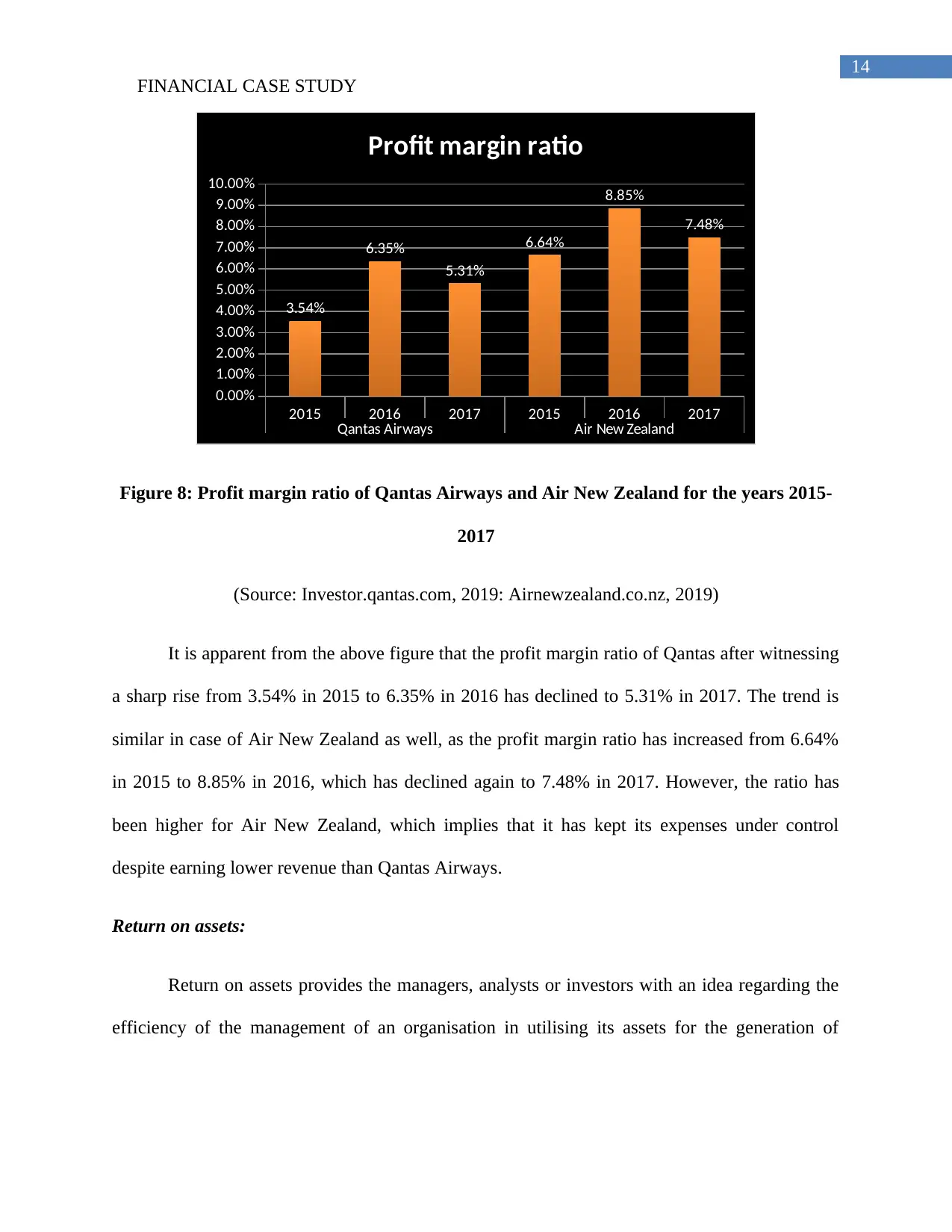
14
FINANCIAL CASE STUDY
2015 2016 2017 2015 2016 2017
Qantas Airways Air New Zealand
0.00%
1.00%
2.00%
3.00%
4.00%
5.00%
6.00%
7.00%
8.00%
9.00%
10.00%
3.54%
6.35%
5.31%
6.64%
8.85%
7.48%
Profit margin ratio
Figure 8: Profit margin ratio of Qantas Airways and Air New Zealand for the years 2015-
2017
(Source: Investor.qantas.com, 2019: Airnewzealand.co.nz, 2019)
It is apparent from the above figure that the profit margin ratio of Qantas after witnessing
a sharp rise from 3.54% in 2015 to 6.35% in 2016 has declined to 5.31% in 2017. The trend is
similar in case of Air New Zealand as well, as the profit margin ratio has increased from 6.64%
in 2015 to 8.85% in 2016, which has declined again to 7.48% in 2017. However, the ratio has
been higher for Air New Zealand, which implies that it has kept its expenses under control
despite earning lower revenue than Qantas Airways.
Return on assets:
Return on assets provides the managers, analysts or investors with an idea regarding the
efficiency of the management of an organisation in utilising its assets for the generation of
FINANCIAL CASE STUDY
2015 2016 2017 2015 2016 2017
Qantas Airways Air New Zealand
0.00%
1.00%
2.00%
3.00%
4.00%
5.00%
6.00%
7.00%
8.00%
9.00%
10.00%
3.54%
6.35%
5.31%
6.64%
8.85%
7.48%
Profit margin ratio
Figure 8: Profit margin ratio of Qantas Airways and Air New Zealand for the years 2015-
2017
(Source: Investor.qantas.com, 2019: Airnewzealand.co.nz, 2019)
It is apparent from the above figure that the profit margin ratio of Qantas after witnessing
a sharp rise from 3.54% in 2015 to 6.35% in 2016 has declined to 5.31% in 2017. The trend is
similar in case of Air New Zealand as well, as the profit margin ratio has increased from 6.64%
in 2015 to 8.85% in 2016, which has declined again to 7.48% in 2017. However, the ratio has
been higher for Air New Zealand, which implies that it has kept its expenses under control
despite earning lower revenue than Qantas Airways.
Return on assets:
Return on assets provides the managers, analysts or investors with an idea regarding the
efficiency of the management of an organisation in utilising its assets for the generation of
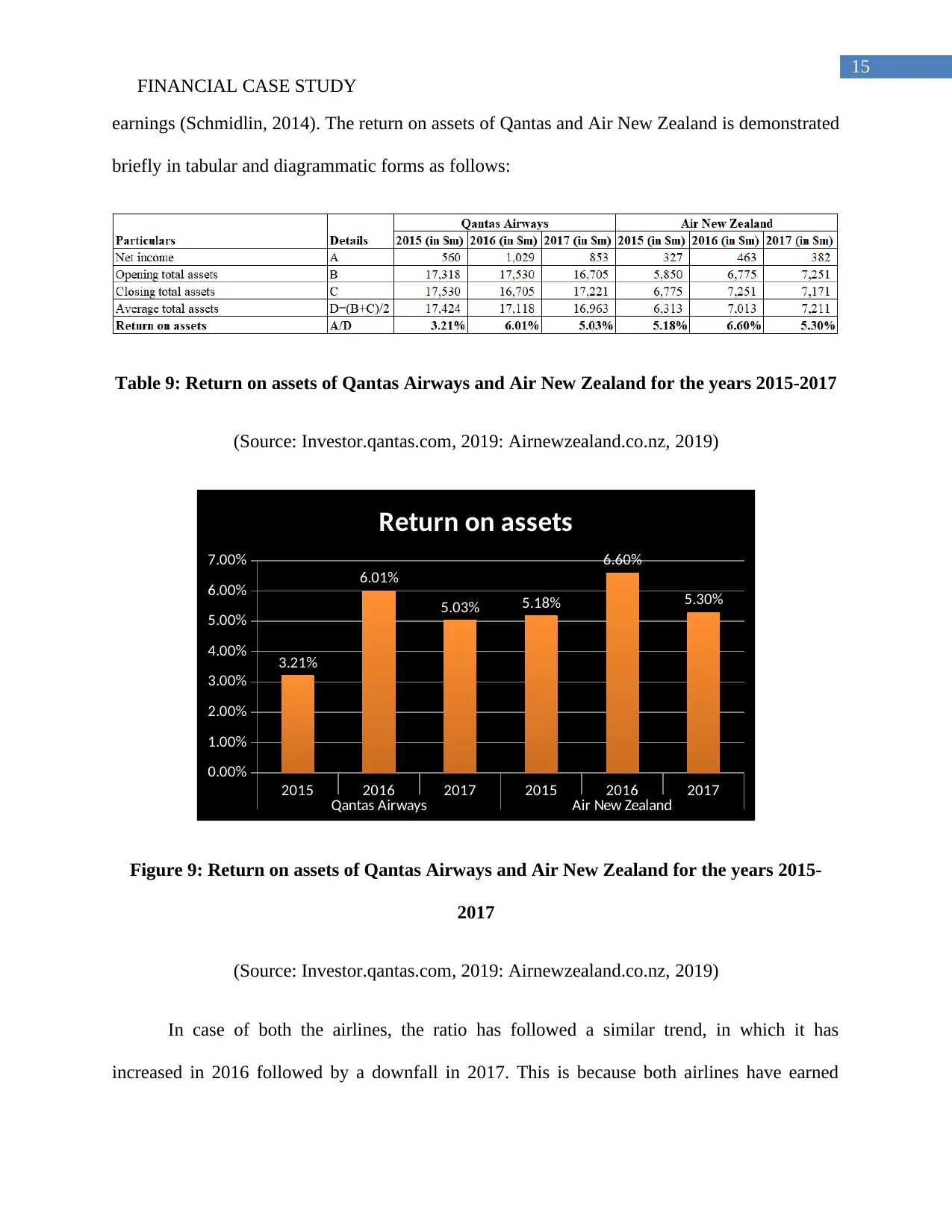
15
FINANCIAL CASE STUDY
earnings (Schmidlin, 2014). The return on assets of Qantas and Air New Zealand is demonstrated
briefly in tabular and diagrammatic forms as follows:
Table 9: Return on assets of Qantas Airways and Air New Zealand for the years 2015-2017
(Source: Investor.qantas.com, 2019: Airnewzealand.co.nz, 2019)
2015 2016 2017 2015 2016 2017
Qantas Airways Air New Zealand
0.00%
1.00%
2.00%
3.00%
4.00%
5.00%
6.00%
7.00%
3.21%
6.01%
5.03% 5.18%
6.60%
5.30%
Return on assets
Figure 9: Return on assets of Qantas Airways and Air New Zealand for the years 2015-
2017
(Source: Investor.qantas.com, 2019: Airnewzealand.co.nz, 2019)
In case of both the airlines, the ratio has followed a similar trend, in which it has
increased in 2016 followed by a downfall in 2017. This is because both airlines have earned
FINANCIAL CASE STUDY
earnings (Schmidlin, 2014). The return on assets of Qantas and Air New Zealand is demonstrated
briefly in tabular and diagrammatic forms as follows:
Table 9: Return on assets of Qantas Airways and Air New Zealand for the years 2015-2017
(Source: Investor.qantas.com, 2019: Airnewzealand.co.nz, 2019)
2015 2016 2017 2015 2016 2017
Qantas Airways Air New Zealand
0.00%
1.00%
2.00%
3.00%
4.00%
5.00%
6.00%
7.00%
3.21%
6.01%
5.03% 5.18%
6.60%
5.30%
Return on assets
Figure 9: Return on assets of Qantas Airways and Air New Zealand for the years 2015-
2017
(Source: Investor.qantas.com, 2019: Airnewzealand.co.nz, 2019)
In case of both the airlines, the ratio has followed a similar trend, in which it has
increased in 2016 followed by a downfall in 2017. This is because both airlines have earned
Secure Best Marks with AI Grader
Need help grading? Try our AI Grader for instant feedback on your assignments.

16
FINANCIAL CASE STUDY
lower income in terms of employed assets in their business operations. However, the ratio seems
to be higher for Air New Zealand, which implies that it has utilised its assets slightly in a better
manner than in the case of Qantas for generating earnings.
Return on equity:
This ratio primarily gauges the rate of return that the owners of ordinary stock of an
organisation obtain on their shareholdings (Stepanyan, 2014). The return on equity of Qantas and
Air New Zealand is demonstrated briefly in tabular and diagrammatic forms as follows:
Table 10: Return on equity of Qantas Airways and Air New Zealand for the years 2015-
2017
(Source: Investor.qantas.com, 2019: Airnewzealand.co.nz, 2019)
2015 2016 2017 2015 2016 2017
Qantas Airways Air New Zealand
0.00%
5.00%
10.00%
15.00%
20.00%
25.00%
30.00%
35.00%
17.74%
30.68%
25.09%
17.04%
22.74%
18.66%
Return on equity
FINANCIAL CASE STUDY
lower income in terms of employed assets in their business operations. However, the ratio seems
to be higher for Air New Zealand, which implies that it has utilised its assets slightly in a better
manner than in the case of Qantas for generating earnings.
Return on equity:
This ratio primarily gauges the rate of return that the owners of ordinary stock of an
organisation obtain on their shareholdings (Stepanyan, 2014). The return on equity of Qantas and
Air New Zealand is demonstrated briefly in tabular and diagrammatic forms as follows:
Table 10: Return on equity of Qantas Airways and Air New Zealand for the years 2015-
2017
(Source: Investor.qantas.com, 2019: Airnewzealand.co.nz, 2019)
2015 2016 2017 2015 2016 2017
Qantas Airways Air New Zealand
0.00%
5.00%
10.00%
15.00%
20.00%
25.00%
30.00%
35.00%
17.74%
30.68%
25.09%
17.04%
22.74%
18.66%
Return on equity
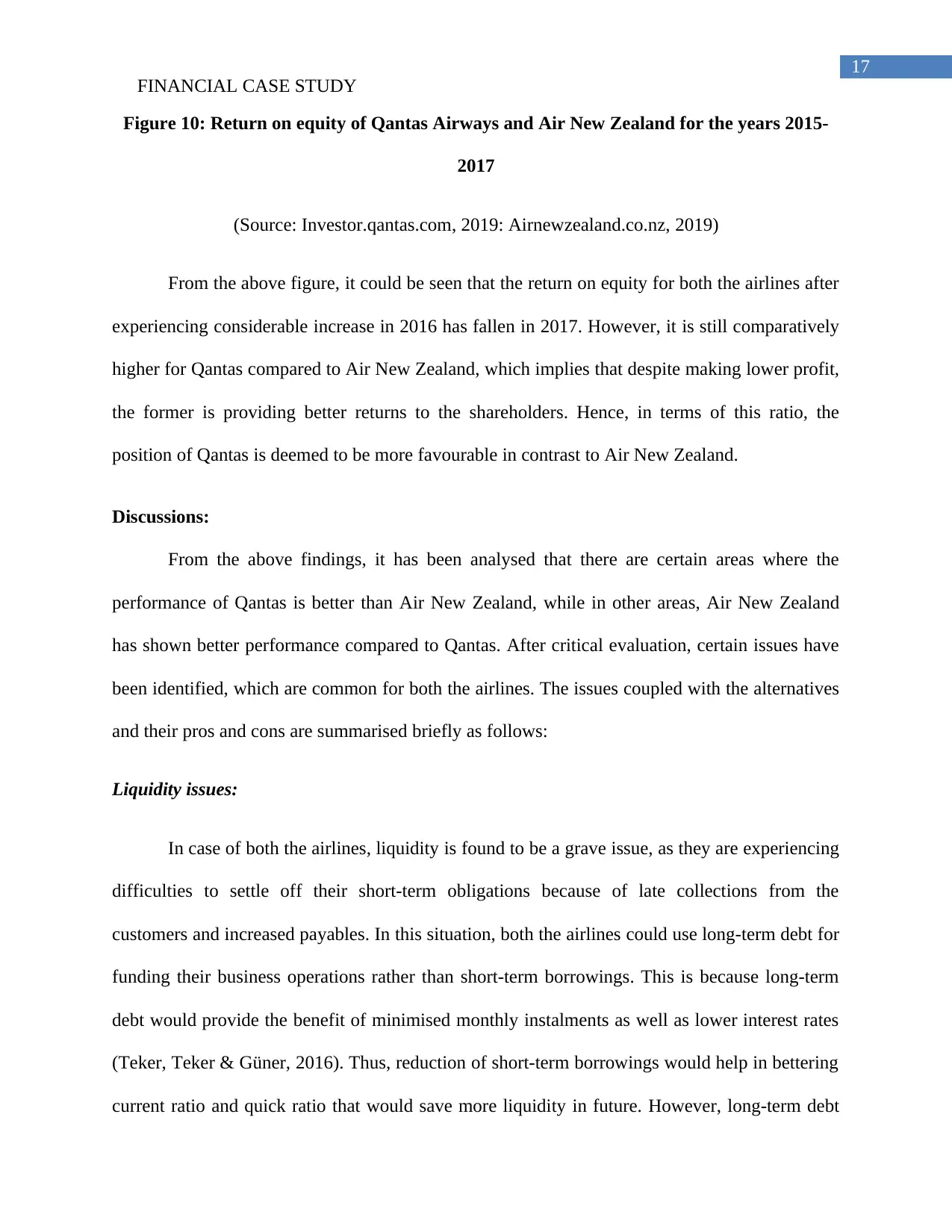
17
FINANCIAL CASE STUDY
Figure 10: Return on equity of Qantas Airways and Air New Zealand for the years 2015-
2017
(Source: Investor.qantas.com, 2019: Airnewzealand.co.nz, 2019)
From the above figure, it could be seen that the return on equity for both the airlines after
experiencing considerable increase in 2016 has fallen in 2017. However, it is still comparatively
higher for Qantas compared to Air New Zealand, which implies that despite making lower profit,
the former is providing better returns to the shareholders. Hence, in terms of this ratio, the
position of Qantas is deemed to be more favourable in contrast to Air New Zealand.
Discussions:
From the above findings, it has been analysed that there are certain areas where the
performance of Qantas is better than Air New Zealand, while in other areas, Air New Zealand
has shown better performance compared to Qantas. After critical evaluation, certain issues have
been identified, which are common for both the airlines. The issues coupled with the alternatives
and their pros and cons are summarised briefly as follows:
Liquidity issues:
In case of both the airlines, liquidity is found to be a grave issue, as they are experiencing
difficulties to settle off their short-term obligations because of late collections from the
customers and increased payables. In this situation, both the airlines could use long-term debt for
funding their business operations rather than short-term borrowings. This is because long-term
debt would provide the benefit of minimised monthly instalments as well as lower interest rates
(Teker, Teker & Güner, 2016). Thus, reduction of short-term borrowings would help in bettering
current ratio and quick ratio that would save more liquidity in future. However, long-term debt
FINANCIAL CASE STUDY
Figure 10: Return on equity of Qantas Airways and Air New Zealand for the years 2015-
2017
(Source: Investor.qantas.com, 2019: Airnewzealand.co.nz, 2019)
From the above figure, it could be seen that the return on equity for both the airlines after
experiencing considerable increase in 2016 has fallen in 2017. However, it is still comparatively
higher for Qantas compared to Air New Zealand, which implies that despite making lower profit,
the former is providing better returns to the shareholders. Hence, in terms of this ratio, the
position of Qantas is deemed to be more favourable in contrast to Air New Zealand.
Discussions:
From the above findings, it has been analysed that there are certain areas where the
performance of Qantas is better than Air New Zealand, while in other areas, Air New Zealand
has shown better performance compared to Qantas. After critical evaluation, certain issues have
been identified, which are common for both the airlines. The issues coupled with the alternatives
and their pros and cons are summarised briefly as follows:
Liquidity issues:
In case of both the airlines, liquidity is found to be a grave issue, as they are experiencing
difficulties to settle off their short-term obligations because of late collections from the
customers and increased payables. In this situation, both the airlines could use long-term debt for
funding their business operations rather than short-term borrowings. This is because long-term
debt would provide the benefit of minimised monthly instalments as well as lower interest rates
(Teker, Teker & Güner, 2016). Thus, reduction of short-term borrowings would help in bettering
current ratio and quick ratio that would save more liquidity in future. However, long-term debt
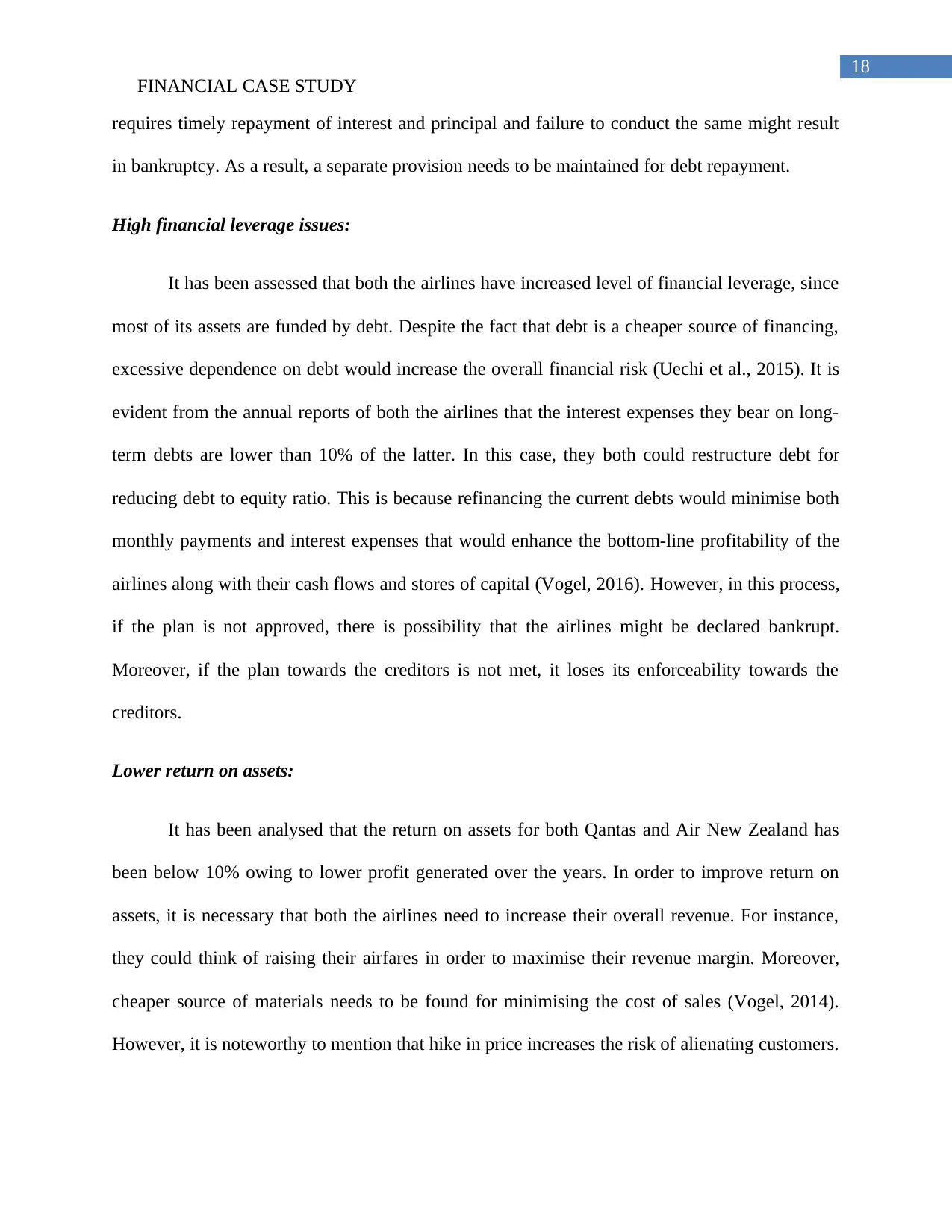
18
FINANCIAL CASE STUDY
requires timely repayment of interest and principal and failure to conduct the same might result
in bankruptcy. As a result, a separate provision needs to be maintained for debt repayment.
High financial leverage issues:
It has been assessed that both the airlines have increased level of financial leverage, since
most of its assets are funded by debt. Despite the fact that debt is a cheaper source of financing,
excessive dependence on debt would increase the overall financial risk (Uechi et al., 2015). It is
evident from the annual reports of both the airlines that the interest expenses they bear on long-
term debts are lower than 10% of the latter. In this case, they both could restructure debt for
reducing debt to equity ratio. This is because refinancing the current debts would minimise both
monthly payments and interest expenses that would enhance the bottom-line profitability of the
airlines along with their cash flows and stores of capital (Vogel, 2016). However, in this process,
if the plan is not approved, there is possibility that the airlines might be declared bankrupt.
Moreover, if the plan towards the creditors is not met, it loses its enforceability towards the
creditors.
Lower return on assets:
It has been analysed that the return on assets for both Qantas and Air New Zealand has
been below 10% owing to lower profit generated over the years. In order to improve return on
assets, it is necessary that both the airlines need to increase their overall revenue. For instance,
they could think of raising their airfares in order to maximise their revenue margin. Moreover,
cheaper source of materials needs to be found for minimising the cost of sales (Vogel, 2014).
However, it is noteworthy to mention that hike in price increases the risk of alienating customers.
FINANCIAL CASE STUDY
requires timely repayment of interest and principal and failure to conduct the same might result
in bankruptcy. As a result, a separate provision needs to be maintained for debt repayment.
High financial leverage issues:
It has been assessed that both the airlines have increased level of financial leverage, since
most of its assets are funded by debt. Despite the fact that debt is a cheaper source of financing,
excessive dependence on debt would increase the overall financial risk (Uechi et al., 2015). It is
evident from the annual reports of both the airlines that the interest expenses they bear on long-
term debts are lower than 10% of the latter. In this case, they both could restructure debt for
reducing debt to equity ratio. This is because refinancing the current debts would minimise both
monthly payments and interest expenses that would enhance the bottom-line profitability of the
airlines along with their cash flows and stores of capital (Vogel, 2016). However, in this process,
if the plan is not approved, there is possibility that the airlines might be declared bankrupt.
Moreover, if the plan towards the creditors is not met, it loses its enforceability towards the
creditors.
Lower return on assets:
It has been analysed that the return on assets for both Qantas and Air New Zealand has
been below 10% owing to lower profit generated over the years. In order to improve return on
assets, it is necessary that both the airlines need to increase their overall revenue. For instance,
they could think of raising their airfares in order to maximise their revenue margin. Moreover,
cheaper source of materials needs to be found for minimising the cost of sales (Vogel, 2014).
However, it is noteworthy to mention that hike in price increases the risk of alienating customers.
Paraphrase This Document
Need a fresh take? Get an instant paraphrase of this document with our AI Paraphraser
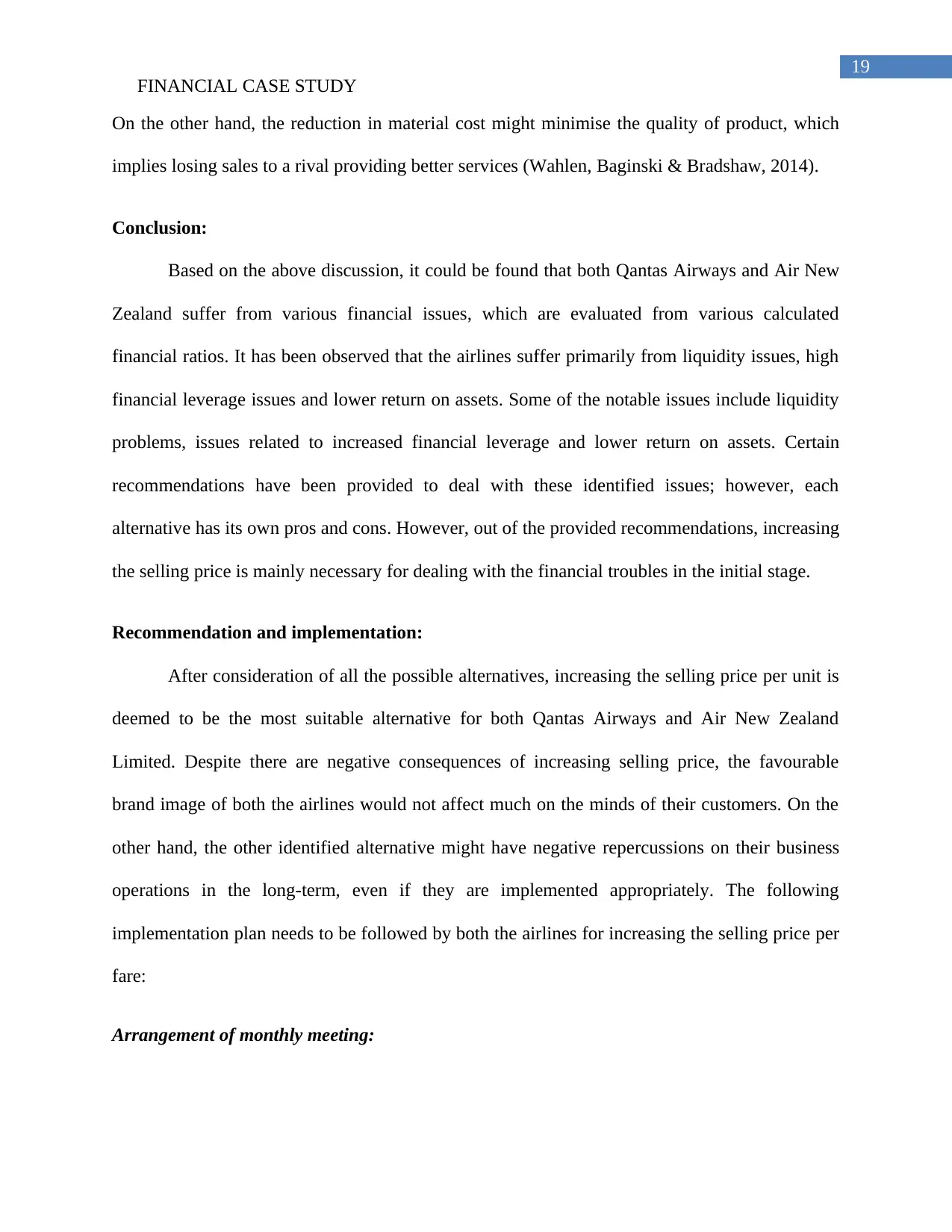
19
FINANCIAL CASE STUDY
On the other hand, the reduction in material cost might minimise the quality of product, which
implies losing sales to a rival providing better services (Wahlen, Baginski & Bradshaw, 2014).
Conclusion:
Based on the above discussion, it could be found that both Qantas Airways and Air New
Zealand suffer from various financial issues, which are evaluated from various calculated
financial ratios. It has been observed that the airlines suffer primarily from liquidity issues, high
financial leverage issues and lower return on assets. Some of the notable issues include liquidity
problems, issues related to increased financial leverage and lower return on assets. Certain
recommendations have been provided to deal with these identified issues; however, each
alternative has its own pros and cons. However, out of the provided recommendations, increasing
the selling price is mainly necessary for dealing with the financial troubles in the initial stage.
Recommendation and implementation:
After consideration of all the possible alternatives, increasing the selling price per unit is
deemed to be the most suitable alternative for both Qantas Airways and Air New Zealand
Limited. Despite there are negative consequences of increasing selling price, the favourable
brand image of both the airlines would not affect much on the minds of their customers. On the
other hand, the other identified alternative might have negative repercussions on their business
operations in the long-term, even if they are implemented appropriately. The following
implementation plan needs to be followed by both the airlines for increasing the selling price per
fare:
Arrangement of monthly meeting:
FINANCIAL CASE STUDY
On the other hand, the reduction in material cost might minimise the quality of product, which
implies losing sales to a rival providing better services (Wahlen, Baginski & Bradshaw, 2014).
Conclusion:
Based on the above discussion, it could be found that both Qantas Airways and Air New
Zealand suffer from various financial issues, which are evaluated from various calculated
financial ratios. It has been observed that the airlines suffer primarily from liquidity issues, high
financial leverage issues and lower return on assets. Some of the notable issues include liquidity
problems, issues related to increased financial leverage and lower return on assets. Certain
recommendations have been provided to deal with these identified issues; however, each
alternative has its own pros and cons. However, out of the provided recommendations, increasing
the selling price is mainly necessary for dealing with the financial troubles in the initial stage.
Recommendation and implementation:
After consideration of all the possible alternatives, increasing the selling price per unit is
deemed to be the most suitable alternative for both Qantas Airways and Air New Zealand
Limited. Despite there are negative consequences of increasing selling price, the favourable
brand image of both the airlines would not affect much on the minds of their customers. On the
other hand, the other identified alternative might have negative repercussions on their business
operations in the long-term, even if they are implemented appropriately. The following
implementation plan needs to be followed by both the airlines for increasing the selling price per
fare:
Arrangement of monthly meeting:
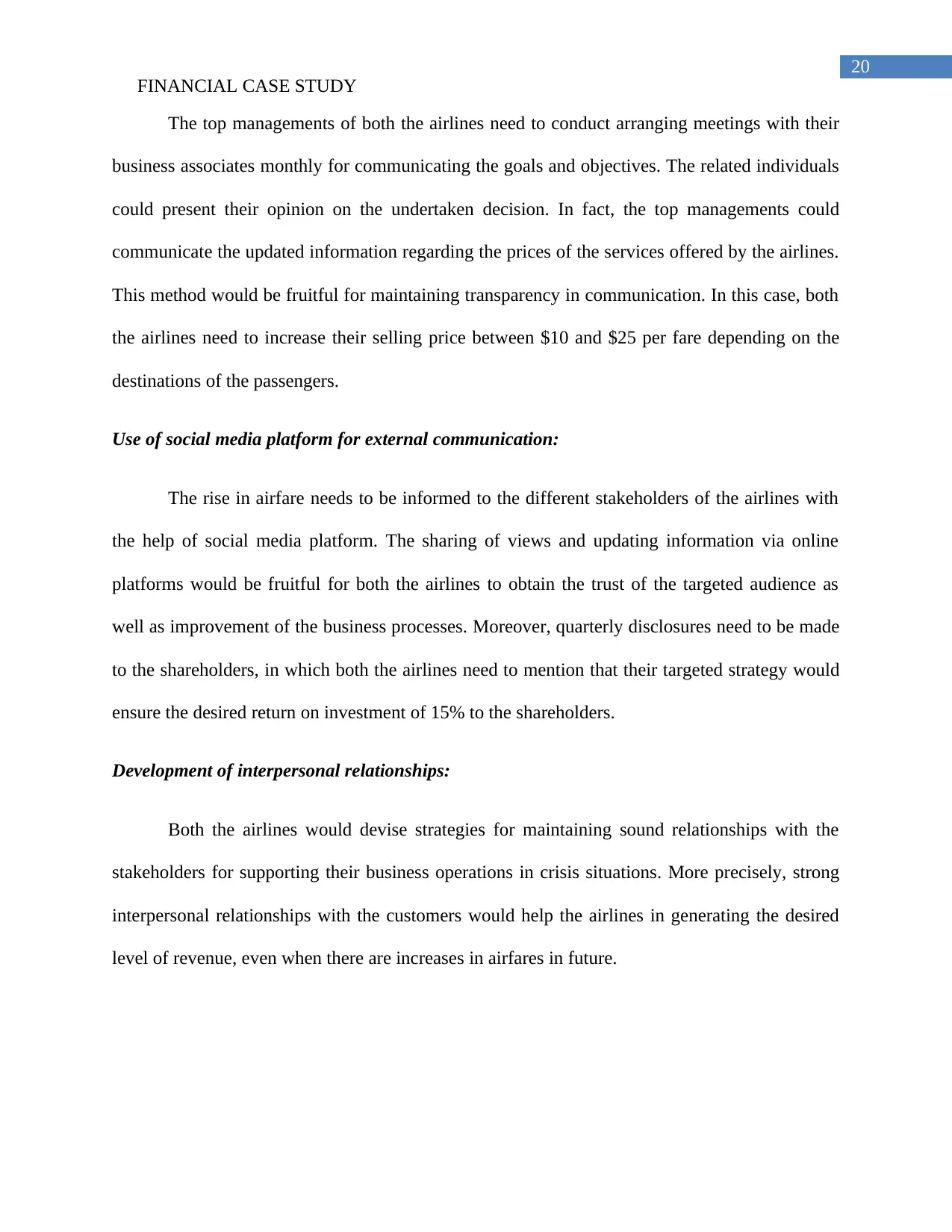
20
FINANCIAL CASE STUDY
The top managements of both the airlines need to conduct arranging meetings with their
business associates monthly for communicating the goals and objectives. The related individuals
could present their opinion on the undertaken decision. In fact, the top managements could
communicate the updated information regarding the prices of the services offered by the airlines.
This method would be fruitful for maintaining transparency in communication. In this case, both
the airlines need to increase their selling price between $10 and $25 per fare depending on the
destinations of the passengers.
Use of social media platform for external communication:
The rise in airfare needs to be informed to the different stakeholders of the airlines with
the help of social media platform. The sharing of views and updating information via online
platforms would be fruitful for both the airlines to obtain the trust of the targeted audience as
well as improvement of the business processes. Moreover, quarterly disclosures need to be made
to the shareholders, in which both the airlines need to mention that their targeted strategy would
ensure the desired return on investment of 15% to the shareholders.
Development of interpersonal relationships:
Both the airlines would devise strategies for maintaining sound relationships with the
stakeholders for supporting their business operations in crisis situations. More precisely, strong
interpersonal relationships with the customers would help the airlines in generating the desired
level of revenue, even when there are increases in airfares in future.
FINANCIAL CASE STUDY
The top managements of both the airlines need to conduct arranging meetings with their
business associates monthly for communicating the goals and objectives. The related individuals
could present their opinion on the undertaken decision. In fact, the top managements could
communicate the updated information regarding the prices of the services offered by the airlines.
This method would be fruitful for maintaining transparency in communication. In this case, both
the airlines need to increase their selling price between $10 and $25 per fare depending on the
destinations of the passengers.
Use of social media platform for external communication:
The rise in airfare needs to be informed to the different stakeholders of the airlines with
the help of social media platform. The sharing of views and updating information via online
platforms would be fruitful for both the airlines to obtain the trust of the targeted audience as
well as improvement of the business processes. Moreover, quarterly disclosures need to be made
to the shareholders, in which both the airlines need to mention that their targeted strategy would
ensure the desired return on investment of 15% to the shareholders.
Development of interpersonal relationships:
Both the airlines would devise strategies for maintaining sound relationships with the
stakeholders for supporting their business operations in crisis situations. More precisely, strong
interpersonal relationships with the customers would help the airlines in generating the desired
level of revenue, even when there are increases in airfares in future.

21
FINANCIAL CASE STUDY
References:
Airnewzealand.co.nz. (2019). Results centre - annual and interim results - Investor centre | Air
New Zealand. Retrieved 16 February 2019, from https://www.airnewzealand.co.nz/latest-
annual-and-interim-results
Airnewzealand.com.au. (2019). Air New Zealand | Cheap Flights, Airfares & Holidays -
Australia Site. Retrieved 16 February 2019, from https://www.airnewzealand.com.au/
Brigham, E. F., Ehrhardt, M. C., Nason, R. R., & Gessaroli, J. (2016). Financial Managment:
Theory And Practice, Canadian Edition. Nelson Education.
Ehiedu, V. C. (2014). The impact of liquidity on profitability of some selected companies: the
financial statement analysis (FSA) approach. Research Journal of Finance and
Accounting, 5(5), 81-90.
Grant, R. M. (2016). Contemporary strategy analysis: Text and cases edition. John Wiley &
Sons.
Investor.qantas.com. (2019). Qantas Investors | Investor Centre. Retrieved 16 February 2019,
from https://investor.qantas.com/investors/?page=annual-reports
Islam, M. A. (2014). An analysis of the financial performance of national bank limited using
financial ratio. Journal of Behavioural Economics, Finance, Entrepreneurship,
Accounting and Transport, 2(5), 121-129.
Jorge-Calderón, D. (2016). Aviation investment: economic appraisal for airports, air traffic
management, airlines and aeronautics. Routledge.
FINANCIAL CASE STUDY
References:
Airnewzealand.co.nz. (2019). Results centre - annual and interim results - Investor centre | Air
New Zealand. Retrieved 16 February 2019, from https://www.airnewzealand.co.nz/latest-
annual-and-interim-results
Airnewzealand.com.au. (2019). Air New Zealand | Cheap Flights, Airfares & Holidays -
Australia Site. Retrieved 16 February 2019, from https://www.airnewzealand.com.au/
Brigham, E. F., Ehrhardt, M. C., Nason, R. R., & Gessaroli, J. (2016). Financial Managment:
Theory And Practice, Canadian Edition. Nelson Education.
Ehiedu, V. C. (2014). The impact of liquidity on profitability of some selected companies: the
financial statement analysis (FSA) approach. Research Journal of Finance and
Accounting, 5(5), 81-90.
Grant, R. M. (2016). Contemporary strategy analysis: Text and cases edition. John Wiley &
Sons.
Investor.qantas.com. (2019). Qantas Investors | Investor Centre. Retrieved 16 February 2019,
from https://investor.qantas.com/investors/?page=annual-reports
Islam, M. A. (2014). An analysis of the financial performance of national bank limited using
financial ratio. Journal of Behavioural Economics, Finance, Entrepreneurship,
Accounting and Transport, 2(5), 121-129.
Jorge-Calderón, D. (2016). Aviation investment: economic appraisal for airports, air traffic
management, airlines and aeronautics. Routledge.
Secure Best Marks with AI Grader
Need help grading? Try our AI Grader for instant feedback on your assignments.
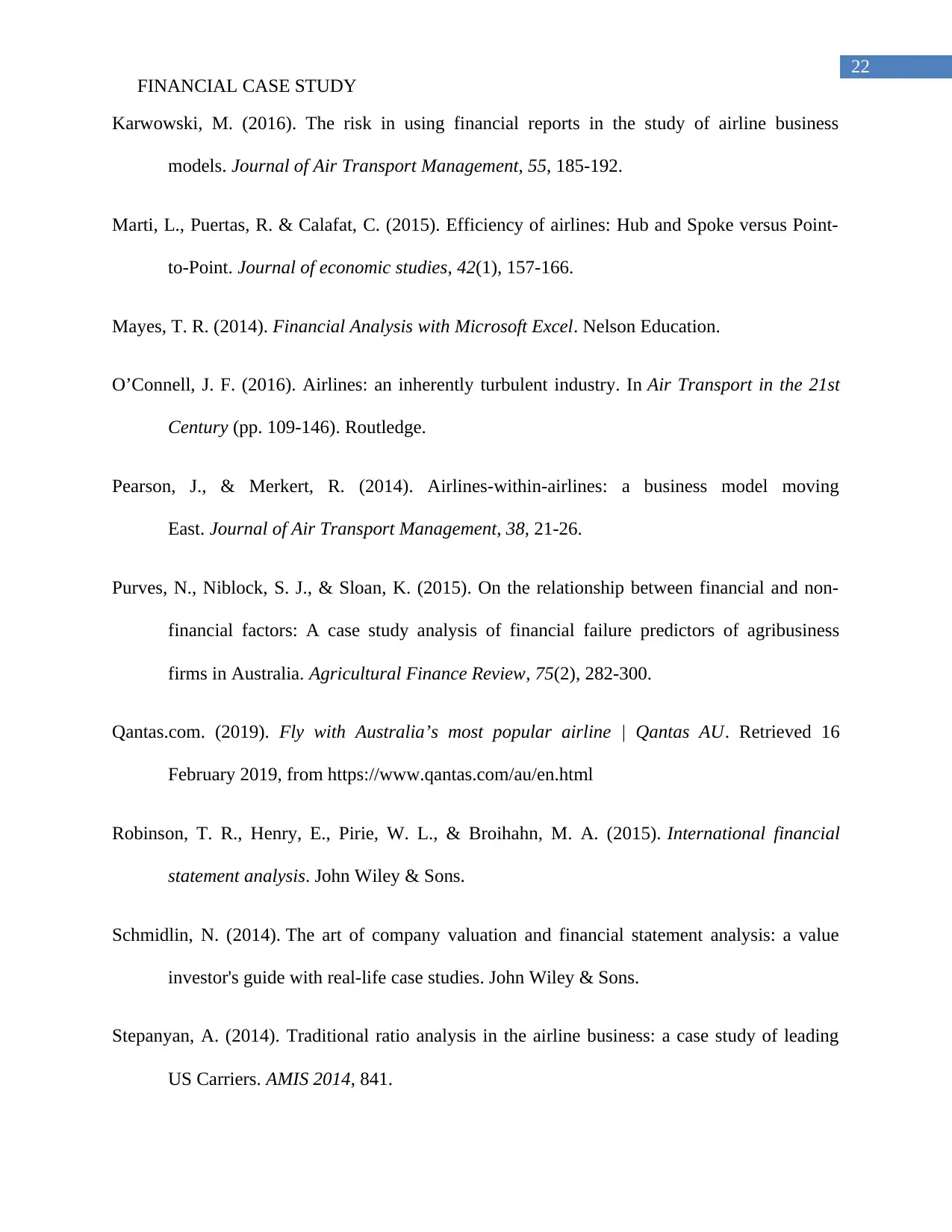
22
FINANCIAL CASE STUDY
Karwowski, M. (2016). The risk in using financial reports in the study of airline business
models. Journal of Air Transport Management, 55, 185-192.
Marti, L., Puertas, R. & Calafat, C. (2015). Efficiency of airlines: Hub and Spoke versus Point-
to-Point. Journal of economic studies, 42(1), 157-166.
Mayes, T. R. (2014). Financial Analysis with Microsoft Excel. Nelson Education.
O’Connell, J. F. (2016). Airlines: an inherently turbulent industry. In Air Transport in the 21st
Century (pp. 109-146). Routledge.
Pearson, J., & Merkert, R. (2014). Airlines-within-airlines: a business model moving
East. Journal of Air Transport Management, 38, 21-26.
Purves, N., Niblock, S. J., & Sloan, K. (2015). On the relationship between financial and non-
financial factors: A case study analysis of financial failure predictors of agribusiness
firms in Australia. Agricultural Finance Review, 75(2), 282-300.
Qantas.com. (2019). Fly with Australia’s most popular airline | Qantas AU. Retrieved 16
February 2019, from https://www.qantas.com/au/en.html
Robinson, T. R., Henry, E., Pirie, W. L., & Broihahn, M. A. (2015). International financial
statement analysis. John Wiley & Sons.
Schmidlin, N. (2014). The art of company valuation and financial statement analysis: a value
investor's guide with real-life case studies. John Wiley & Sons.
Stepanyan, A. (2014). Traditional ratio analysis in the airline business: a case study of leading
US Carriers. AMIS 2014, 841.
FINANCIAL CASE STUDY
Karwowski, M. (2016). The risk in using financial reports in the study of airline business
models. Journal of Air Transport Management, 55, 185-192.
Marti, L., Puertas, R. & Calafat, C. (2015). Efficiency of airlines: Hub and Spoke versus Point-
to-Point. Journal of economic studies, 42(1), 157-166.
Mayes, T. R. (2014). Financial Analysis with Microsoft Excel. Nelson Education.
O’Connell, J. F. (2016). Airlines: an inherently turbulent industry. In Air Transport in the 21st
Century (pp. 109-146). Routledge.
Pearson, J., & Merkert, R. (2014). Airlines-within-airlines: a business model moving
East. Journal of Air Transport Management, 38, 21-26.
Purves, N., Niblock, S. J., & Sloan, K. (2015). On the relationship between financial and non-
financial factors: A case study analysis of financial failure predictors of agribusiness
firms in Australia. Agricultural Finance Review, 75(2), 282-300.
Qantas.com. (2019). Fly with Australia’s most popular airline | Qantas AU. Retrieved 16
February 2019, from https://www.qantas.com/au/en.html
Robinson, T. R., Henry, E., Pirie, W. L., & Broihahn, M. A. (2015). International financial
statement analysis. John Wiley & Sons.
Schmidlin, N. (2014). The art of company valuation and financial statement analysis: a value
investor's guide with real-life case studies. John Wiley & Sons.
Stepanyan, A. (2014). Traditional ratio analysis in the airline business: a case study of leading
US Carriers. AMIS 2014, 841.
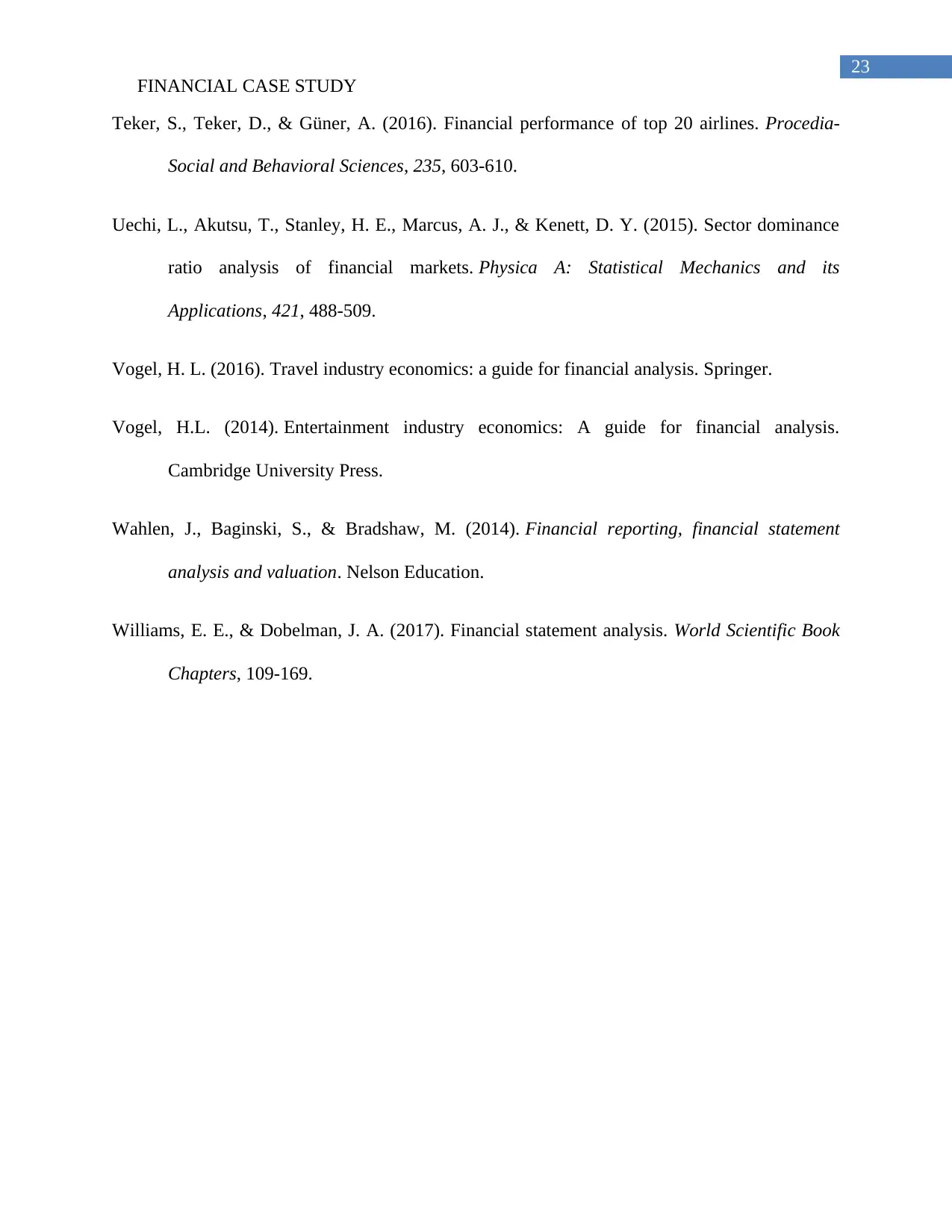
23
FINANCIAL CASE STUDY
Teker, S., Teker, D., & Güner, A. (2016). Financial performance of top 20 airlines. Procedia-
Social and Behavioral Sciences, 235, 603-610.
Uechi, L., Akutsu, T., Stanley, H. E., Marcus, A. J., & Kenett, D. Y. (2015). Sector dominance
ratio analysis of financial markets. Physica A: Statistical Mechanics and its
Applications, 421, 488-509.
Vogel, H. L. (2016). Travel industry economics: a guide for financial analysis. Springer.
Vogel, H.L. (2014). Entertainment industry economics: A guide for financial analysis.
Cambridge University Press.
Wahlen, J., Baginski, S., & Bradshaw, M. (2014). Financial reporting, financial statement
analysis and valuation. Nelson Education.
Williams, E. E., & Dobelman, J. A. (2017). Financial statement analysis. World Scientific Book
Chapters, 109-169.
FINANCIAL CASE STUDY
Teker, S., Teker, D., & Güner, A. (2016). Financial performance of top 20 airlines. Procedia-
Social and Behavioral Sciences, 235, 603-610.
Uechi, L., Akutsu, T., Stanley, H. E., Marcus, A. J., & Kenett, D. Y. (2015). Sector dominance
ratio analysis of financial markets. Physica A: Statistical Mechanics and its
Applications, 421, 488-509.
Vogel, H. L. (2016). Travel industry economics: a guide for financial analysis. Springer.
Vogel, H.L. (2014). Entertainment industry economics: A guide for financial analysis.
Cambridge University Press.
Wahlen, J., Baginski, S., & Bradshaw, M. (2014). Financial reporting, financial statement
analysis and valuation. Nelson Education.
Williams, E. E., & Dobelman, J. A. (2017). Financial statement analysis. World Scientific Book
Chapters, 109-169.
1 out of 24
Related Documents
Your All-in-One AI-Powered Toolkit for Academic Success.
+13062052269
info@desklib.com
Available 24*7 on WhatsApp / Email
![[object Object]](/_next/static/media/star-bottom.7253800d.svg)
Unlock your academic potential
© 2024 | Zucol Services PVT LTD | All rights reserved.




